-
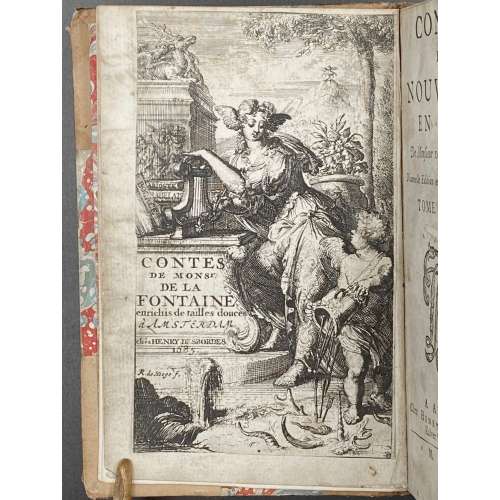 [Jean de LA FONTAINE]. Contes et nouvelles en vers. De Monsieur de La Fontaine. Nouvelle édition enrichie de tailles-douces. À Amsterdam | Chez Henry Desbordes, MDCLXXXV [1685]. — 2 vol. in 1. Pagination: [1] - frontispiece with pasted illustr., [*1] - title p. with blank verso, *2-*5 (only recto numbered) - advertisement, [1] - preface vol. 1, [2] table, 1-236; [6] - preface vol. 2, 1-216, illustr. (in text). Etched frontispiece plate and 58 half-page etchings at the head of each chapter as well as endpiece vignettes, all by R. de Hooge (Romeyn de Hooghe, 1645 – 1708, a Dutch painter, sculptor, engraver and caricaturist. First illustrated edition. "Publication of the scandalous fables was forbidden in France from 1674. According to Van Eeghen, this edition was published without the knowledge of La Fontaine. ...This is the edition with ‘Le Juge de Nêle’ (instead of Mesle) in the contents of the first volume, as well as page 211 for 'Dissertation sur la Joconde'; 16 lines of text on page 211; and 19 lines of text on the first page of the preface of volume 2" [1]. Pott 8vo (15.4 x 10 cm), hardcover; owner's later tan polished half-calf, marbled boards, marbled pastedowns and flyleaves, 5 raised bands, dark brown labels with gilt lettering and gilt roll patterns on spine, tail of the spine slightly damaged. Corners bumped, spotted stains on leather. Henri Desbordes (d. ca. 1722) was a Huguenot printer who was exiled from his business in France and set up as a publisher in Amsterdam in the 17th century.
[Jean de LA FONTAINE]. Contes et nouvelles en vers. De Monsieur de La Fontaine. Nouvelle édition enrichie de tailles-douces. À Amsterdam | Chez Henry Desbordes, MDCLXXXV [1685]. — 2 vol. in 1. Pagination: [1] - frontispiece with pasted illustr., [*1] - title p. with blank verso, *2-*5 (only recto numbered) - advertisement, [1] - preface vol. 1, [2] table, 1-236; [6] - preface vol. 2, 1-216, illustr. (in text). Etched frontispiece plate and 58 half-page etchings at the head of each chapter as well as endpiece vignettes, all by R. de Hooge (Romeyn de Hooghe, 1645 – 1708, a Dutch painter, sculptor, engraver and caricaturist. First illustrated edition. "Publication of the scandalous fables was forbidden in France from 1674. According to Van Eeghen, this edition was published without the knowledge of La Fontaine. ...This is the edition with ‘Le Juge de Nêle’ (instead of Mesle) in the contents of the first volume, as well as page 211 for 'Dissertation sur la Joconde'; 16 lines of text on page 211; and 19 lines of text on the first page of the preface of volume 2" [1]. Pott 8vo (15.4 x 10 cm), hardcover; owner's later tan polished half-calf, marbled boards, marbled pastedowns and flyleaves, 5 raised bands, dark brown labels with gilt lettering and gilt roll patterns on spine, tail of the spine slightly damaged. Corners bumped, spotted stains on leather. Henri Desbordes (d. ca. 1722) was a Huguenot printer who was exiled from his business in France and set up as a publisher in Amsterdam in the 17th century. -
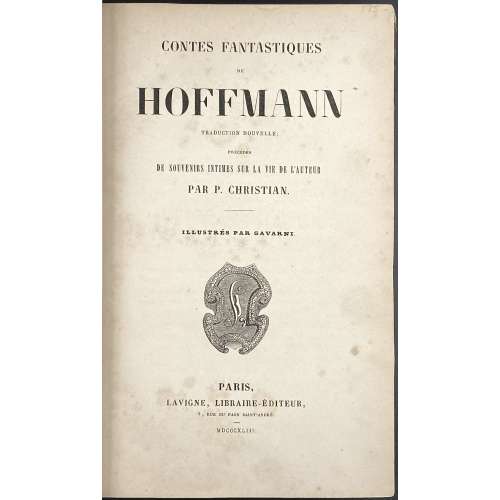 Title: CONTES FANTASTIQUES | DE | HOFFMANN | TRADUCTION NOUVELLE ; PRÉCÉDÉS | DE SOUVENIRS INTIMES SUR LA VIE DE L’AUTEUR | PAR P. CHRISTIAN. | ILLUSTRÉS PAR GAVARNI. | {Publisher’s device} | — PARIS, | LAVIGNE, LIBRAIRE-ÉDITEUR, | 1 RUE DU PAON SAINT-ANDRÉ. | MDCCCXLIII. || Pagination: ffl, [i-vi] –h.t. / colopon, t.p. /blank, dedication /blank, [vii] viii-xix [xx][1,-3] 4-522, bfl, + woodcut illustrations by Brévière et Novionafter Gavarni: 10 full page plates, initials, tail pieces, and in text. Collation: [a]-b4 c2, 1-654 661. Binding: Quarter brown morocco over marbled boards, raised bands with gilt double fillets, gilt arabesque in compartments, title lettering. Catalogue raisonné: L. Carteret (1927), p. 295.
Title: CONTES FANTASTIQUES | DE | HOFFMANN | TRADUCTION NOUVELLE ; PRÉCÉDÉS | DE SOUVENIRS INTIMES SUR LA VIE DE L’AUTEUR | PAR P. CHRISTIAN. | ILLUSTRÉS PAR GAVARNI. | {Publisher’s device} | — PARIS, | LAVIGNE, LIBRAIRE-ÉDITEUR, | 1 RUE DU PAON SAINT-ANDRÉ. | MDCCCXLIII. || Pagination: ffl, [i-vi] –h.t. / colopon, t.p. /blank, dedication /blank, [vii] viii-xix [xx][1,-3] 4-522, bfl, + woodcut illustrations by Brévière et Novionafter Gavarni: 10 full page plates, initials, tail pieces, and in text. Collation: [a]-b4 c2, 1-654 661. Binding: Quarter brown morocco over marbled boards, raised bands with gilt double fillets, gilt arabesque in compartments, title lettering. Catalogue raisonné: L. Carteret (1927), p. 295. -
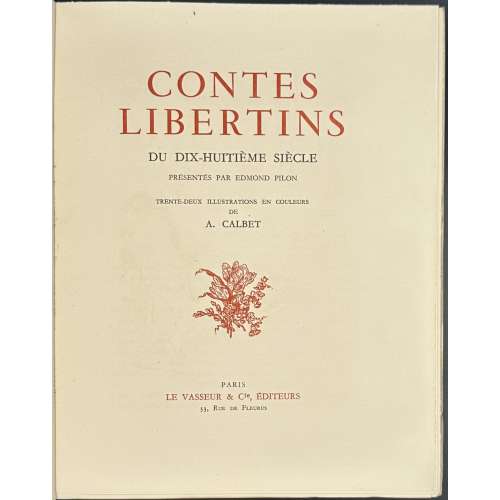 NEWSoftcover, cream French flapped wrappers, 242 x 192 mm, glassine dust jacket, lower and outer margins untrimmed, red lettering to front wrapper CONTES LIBERTINS | DU | DIX-HUITIÈME SIÈCLE; in a double slipcase; 10 full-page colour intaglio prints, incl. frontispiece, and 10 half-page coloured prints after Antoine Calbet; pp.: [1-8] 9-223 [224] [6], total 115 leaves plus ten plates with tissue guards extraneous to collation. Copy enhanced with a full suite of 32 uncoloured intaglio prints, and 12 refused plates:
NEWSoftcover, cream French flapped wrappers, 242 x 192 mm, glassine dust jacket, lower and outer margins untrimmed, red lettering to front wrapper CONTES LIBERTINS | DU | DIX-HUITIÈME SIÈCLE; in a double slipcase; 10 full-page colour intaglio prints, incl. frontispiece, and 10 half-page coloured prints after Antoine Calbet; pp.: [1-8] 9-223 [224] [6], total 115 leaves plus ten plates with tissue guards extraneous to collation. Copy enhanced with a full suite of 32 uncoloured intaglio prints, and 12 refused plates: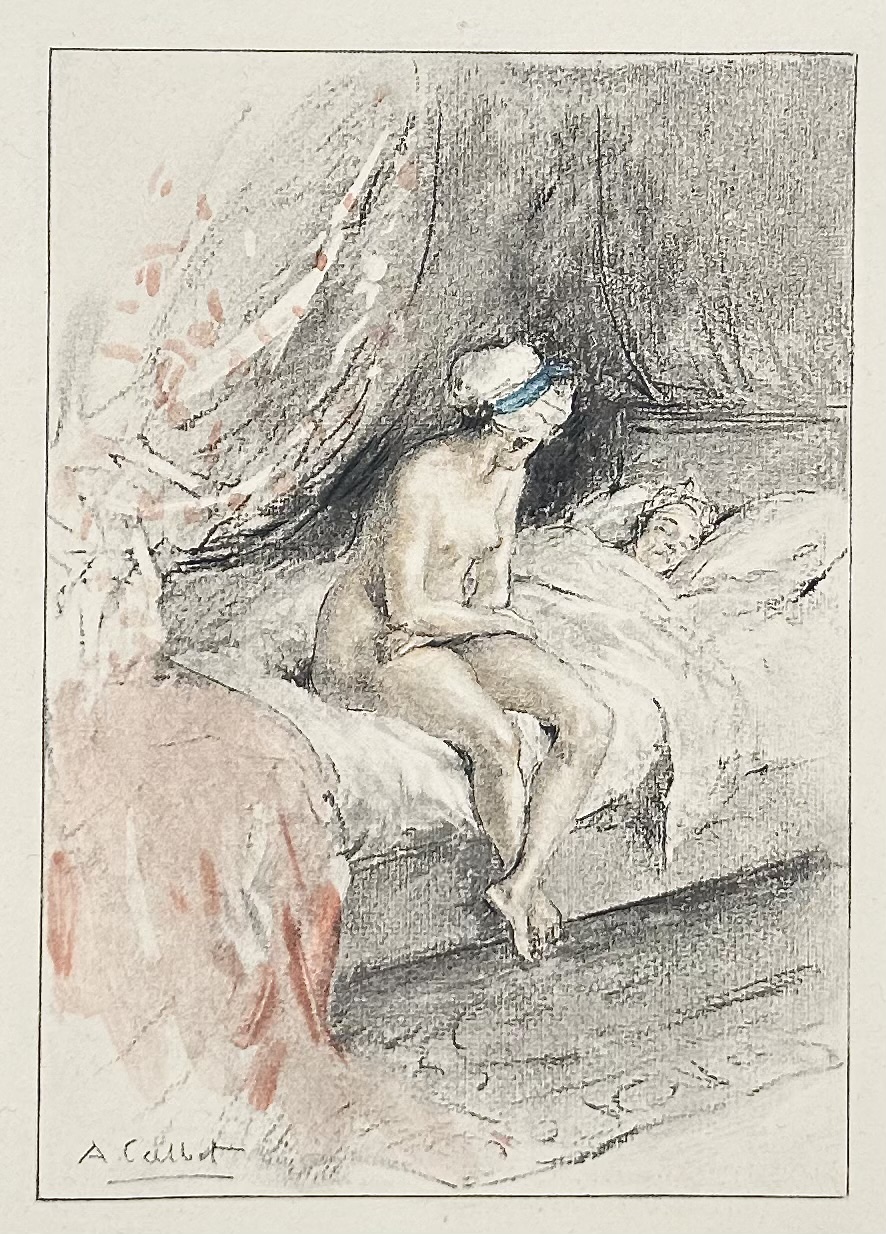
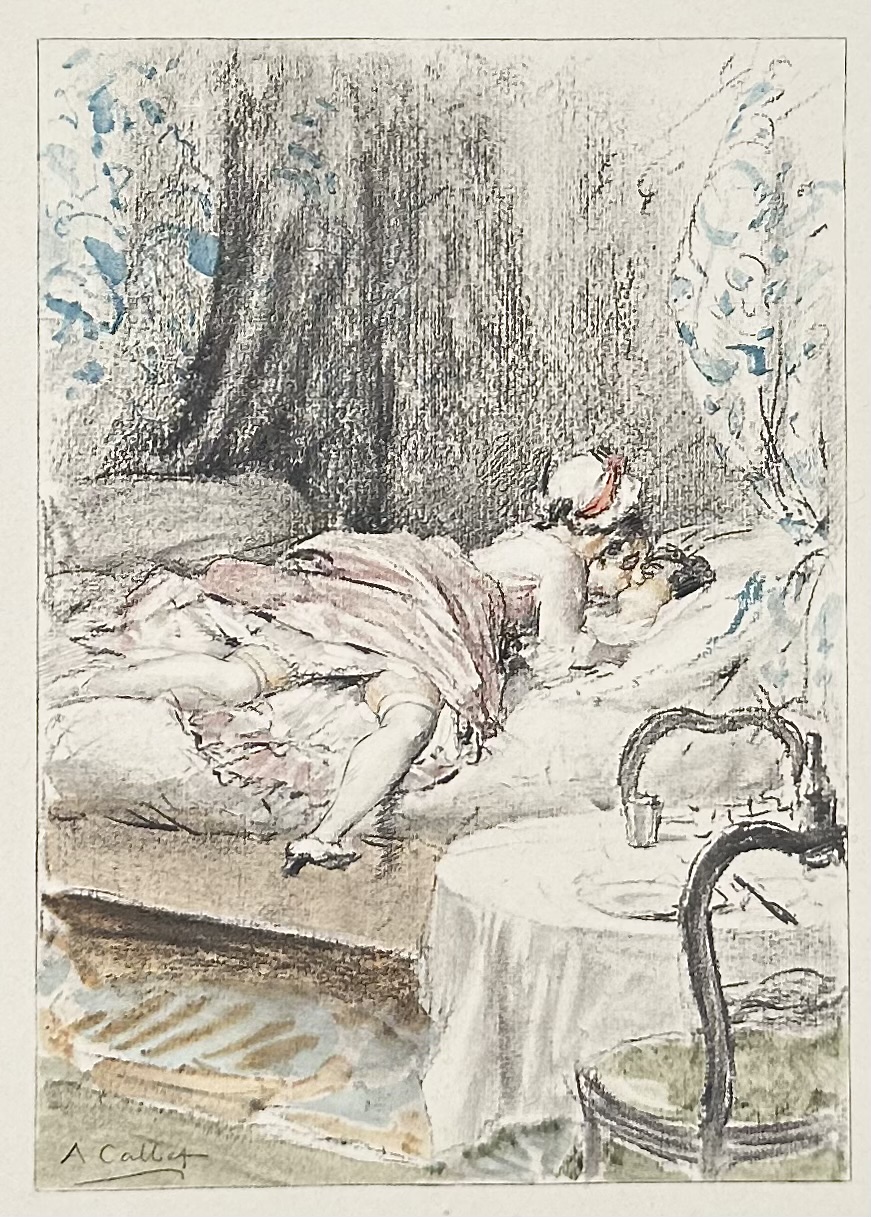
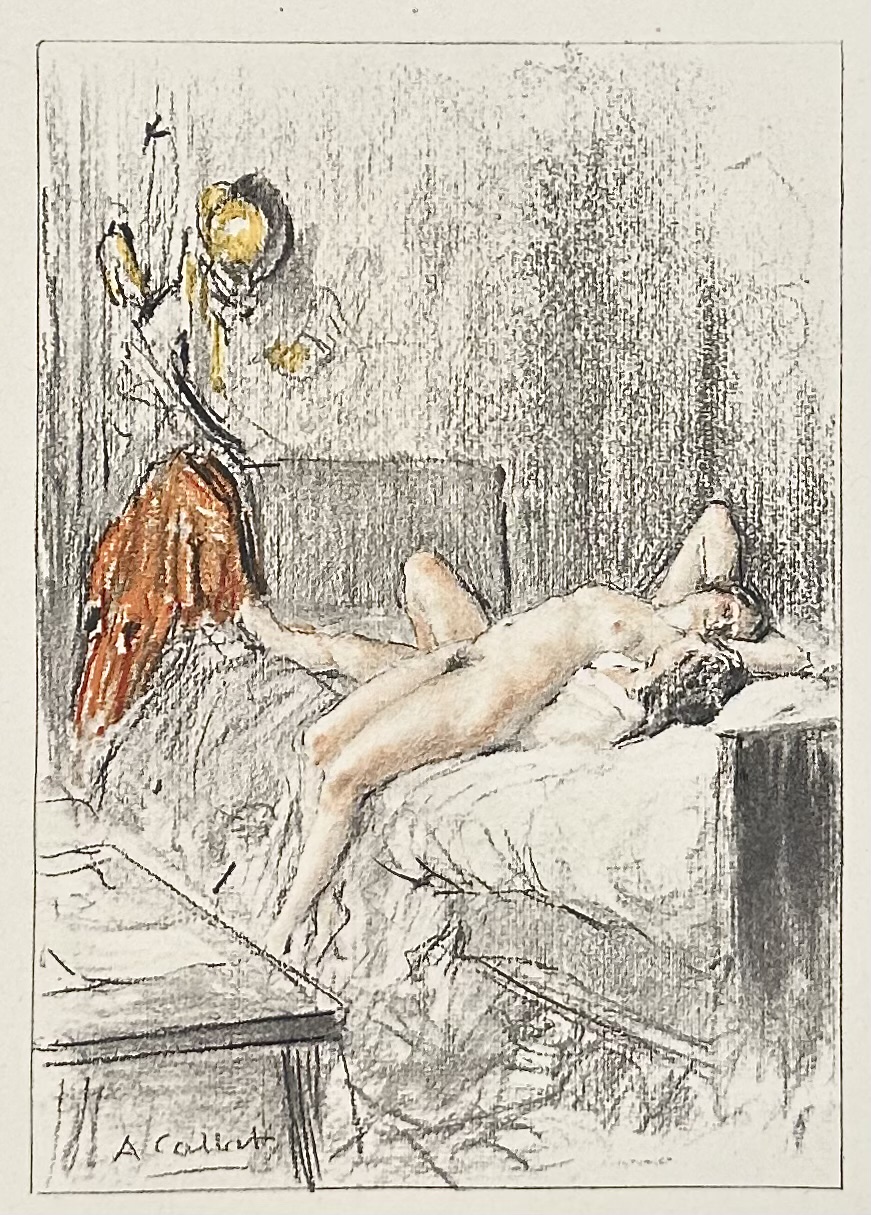
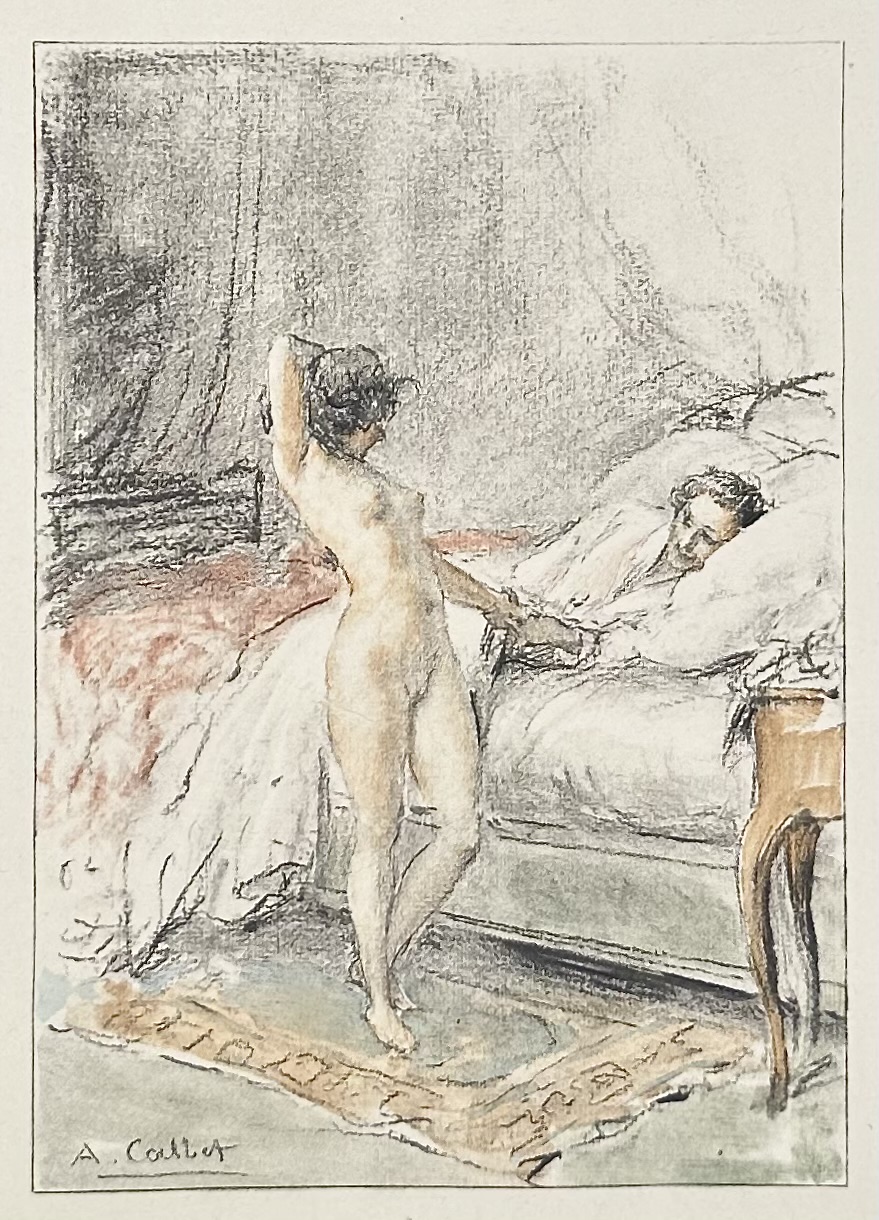
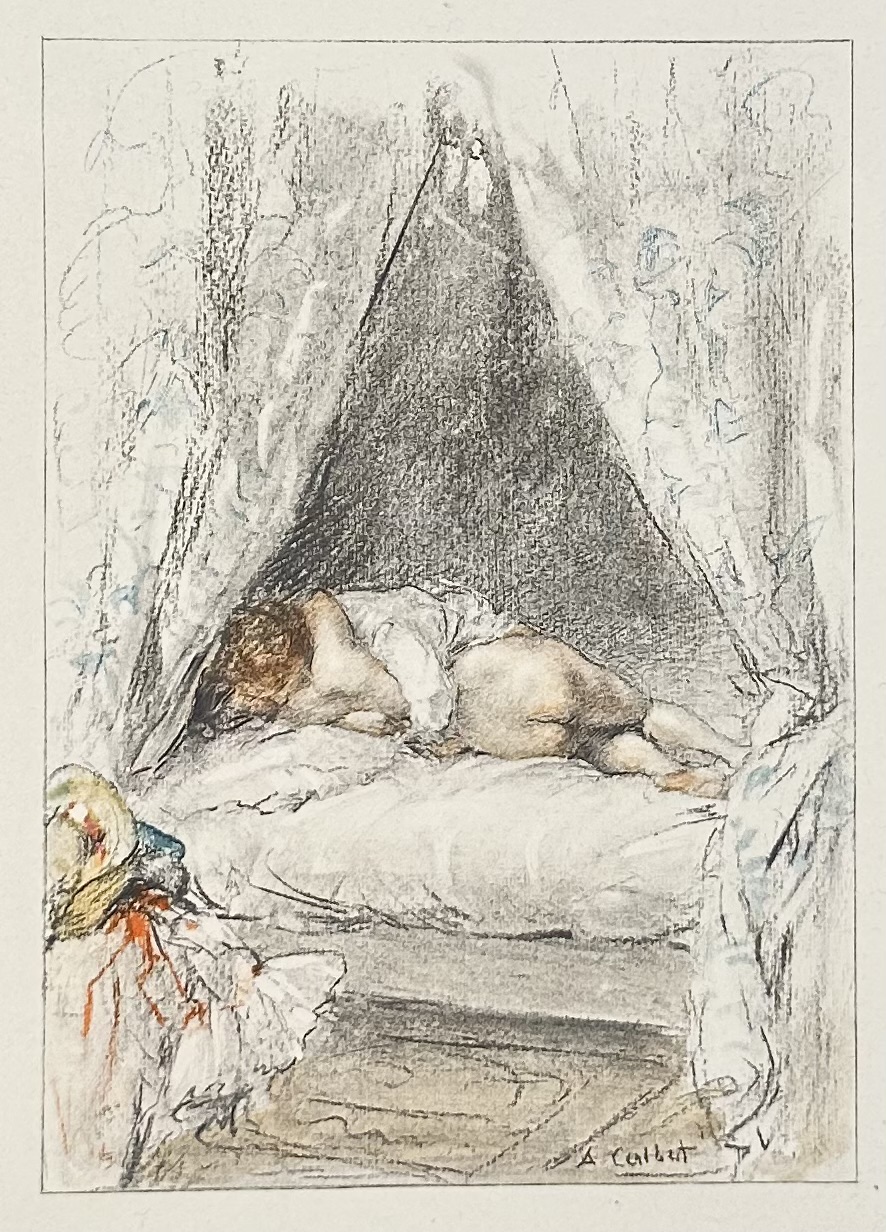
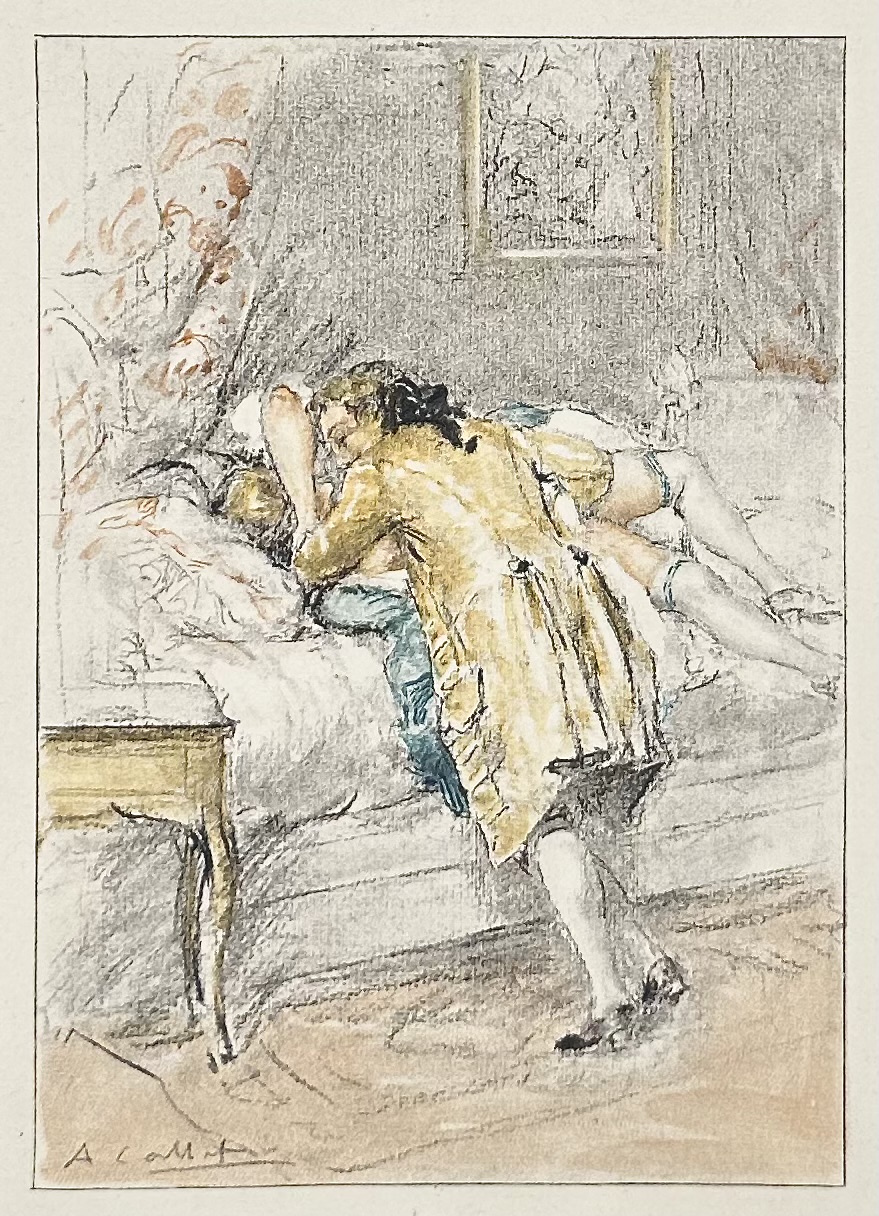
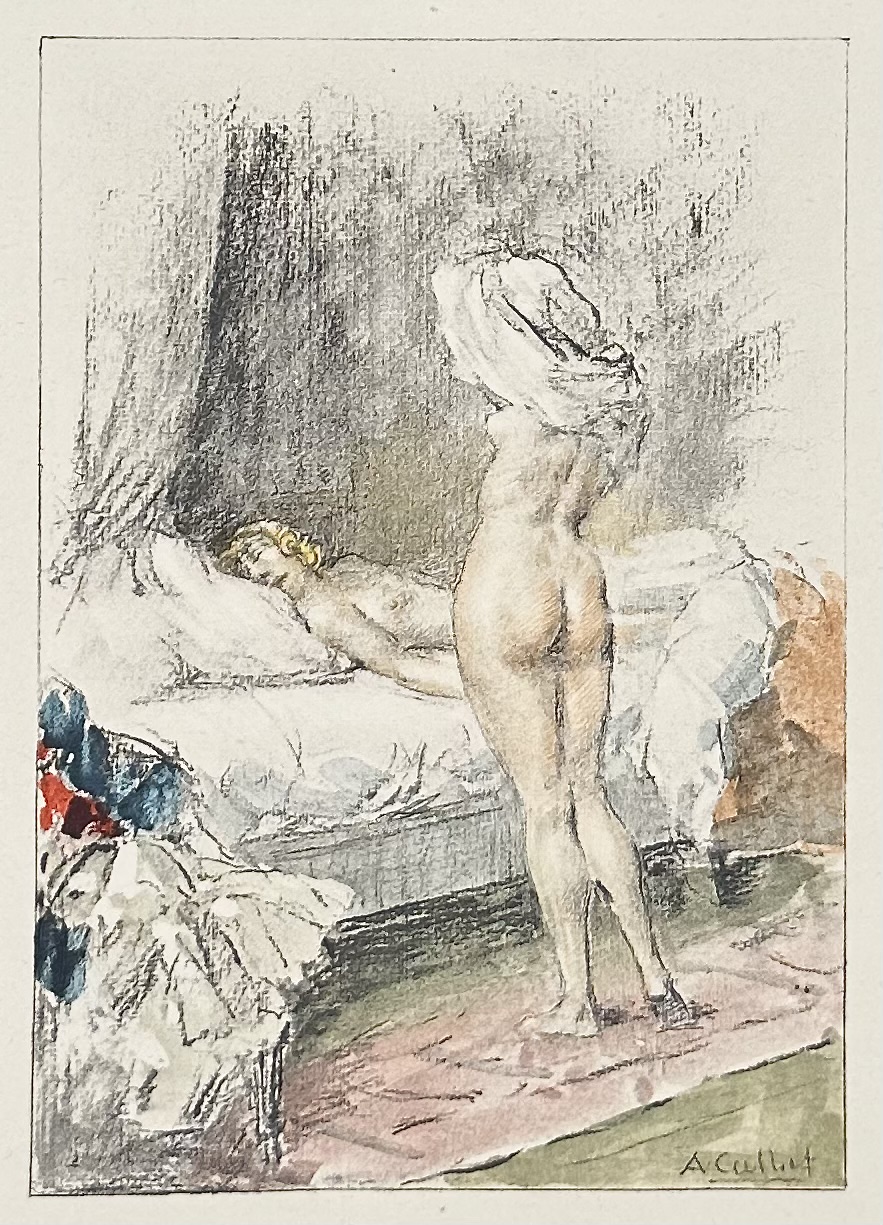
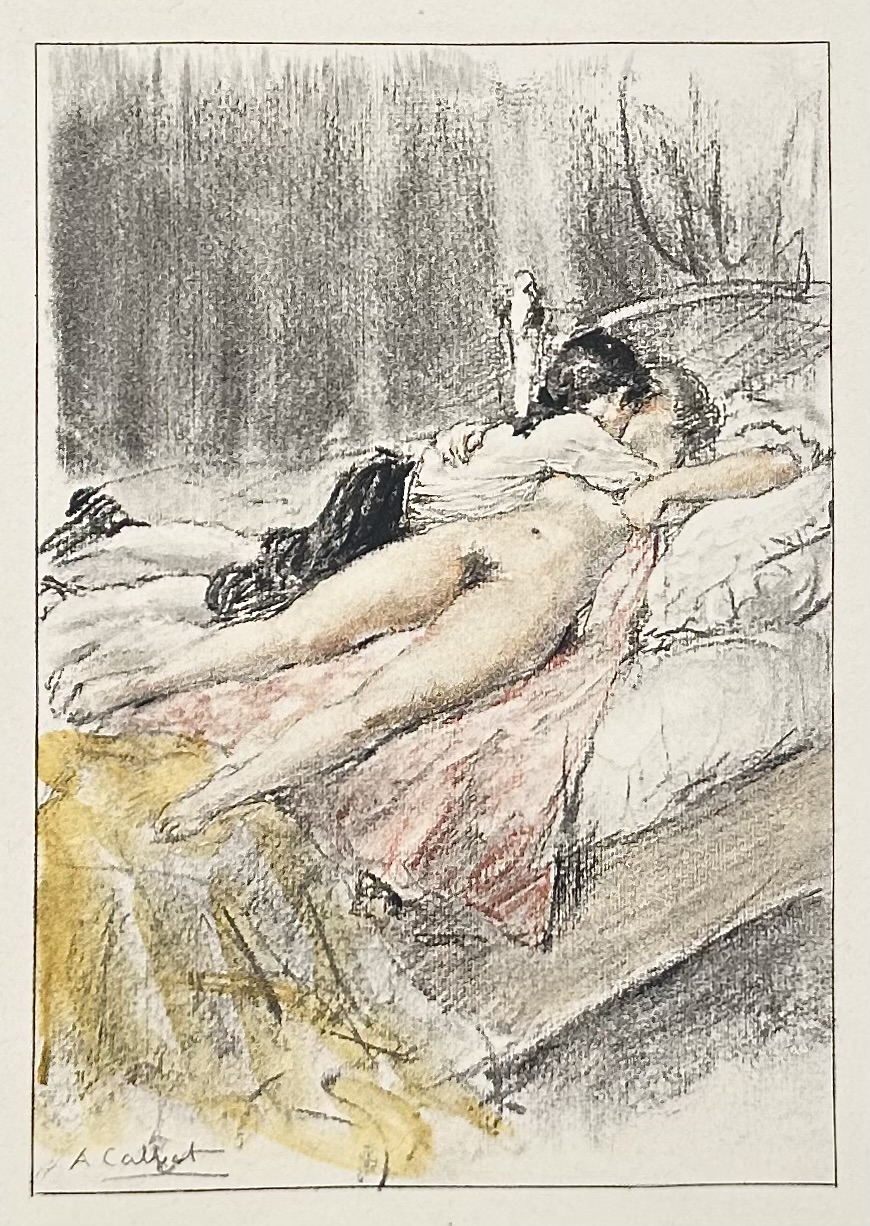
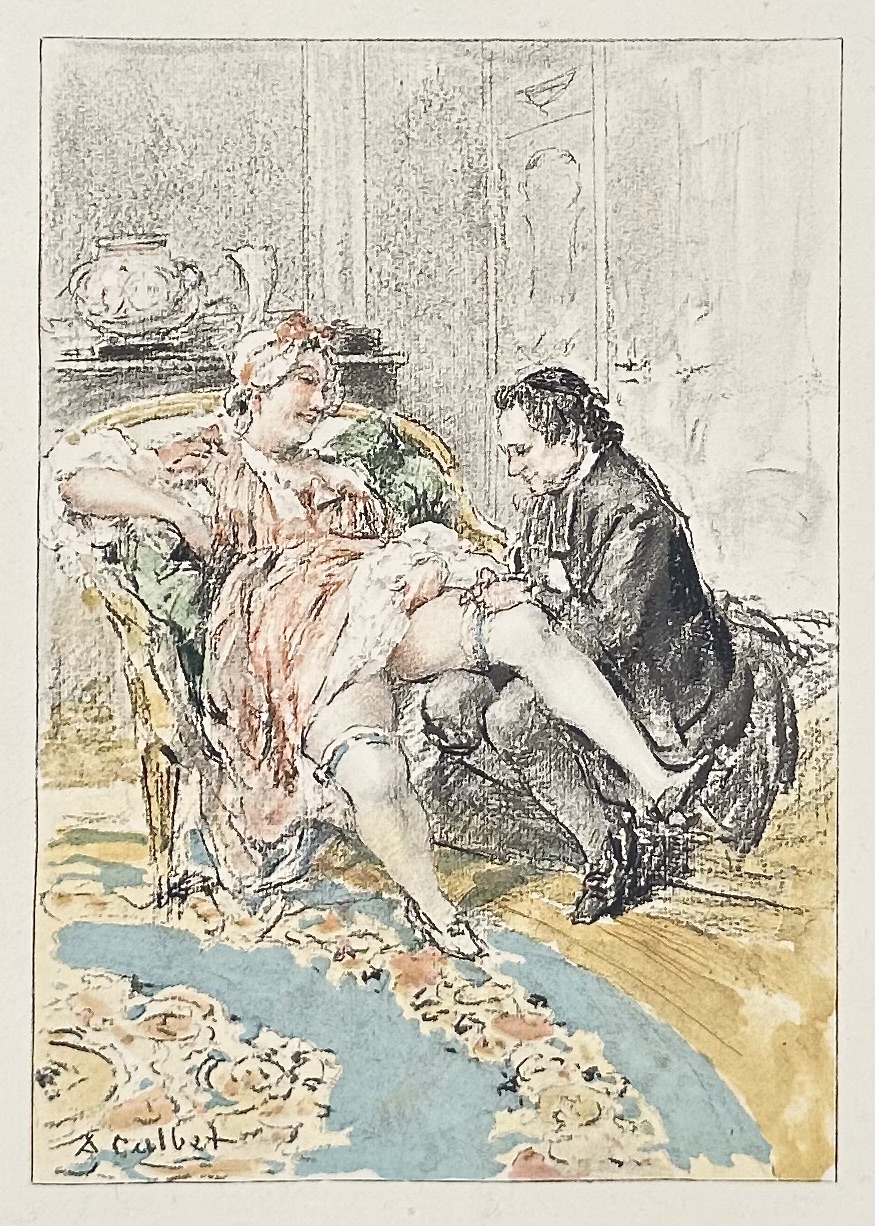
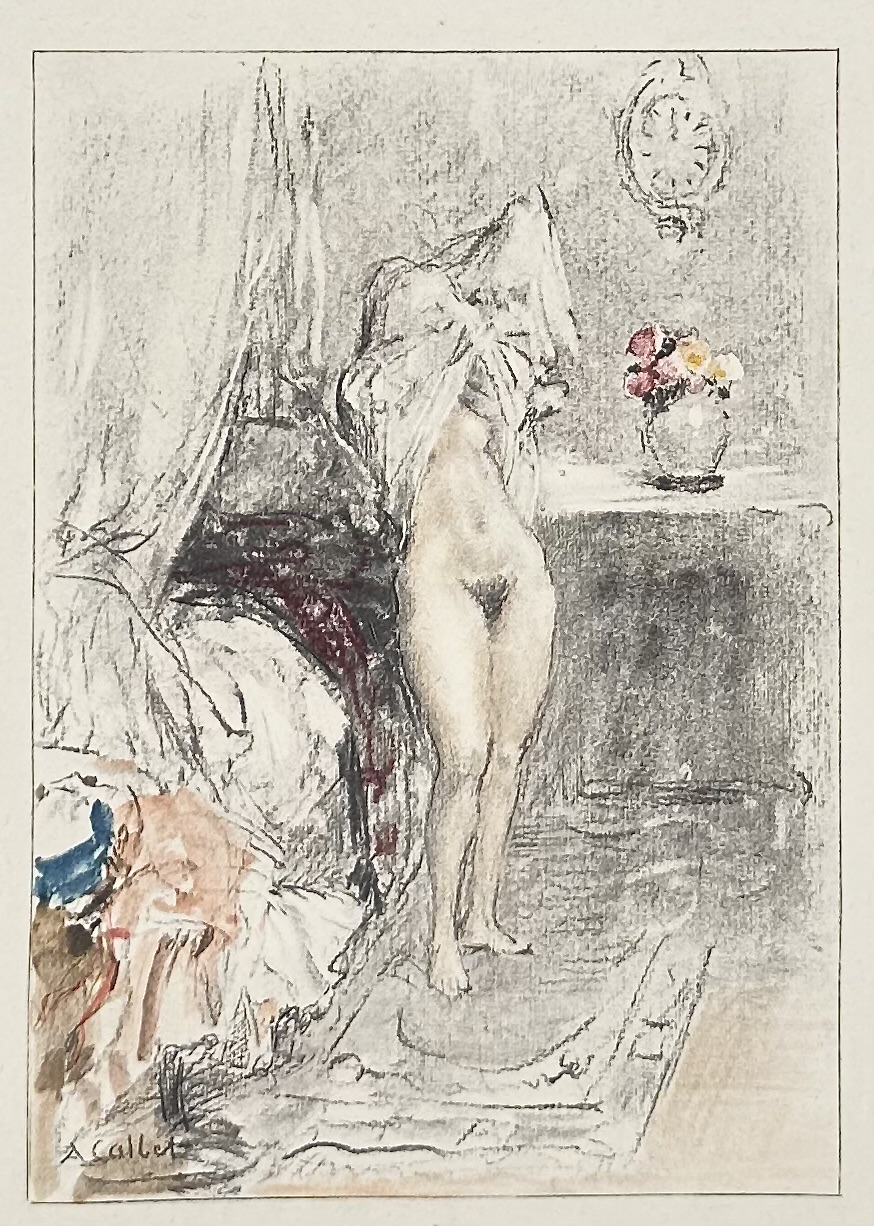
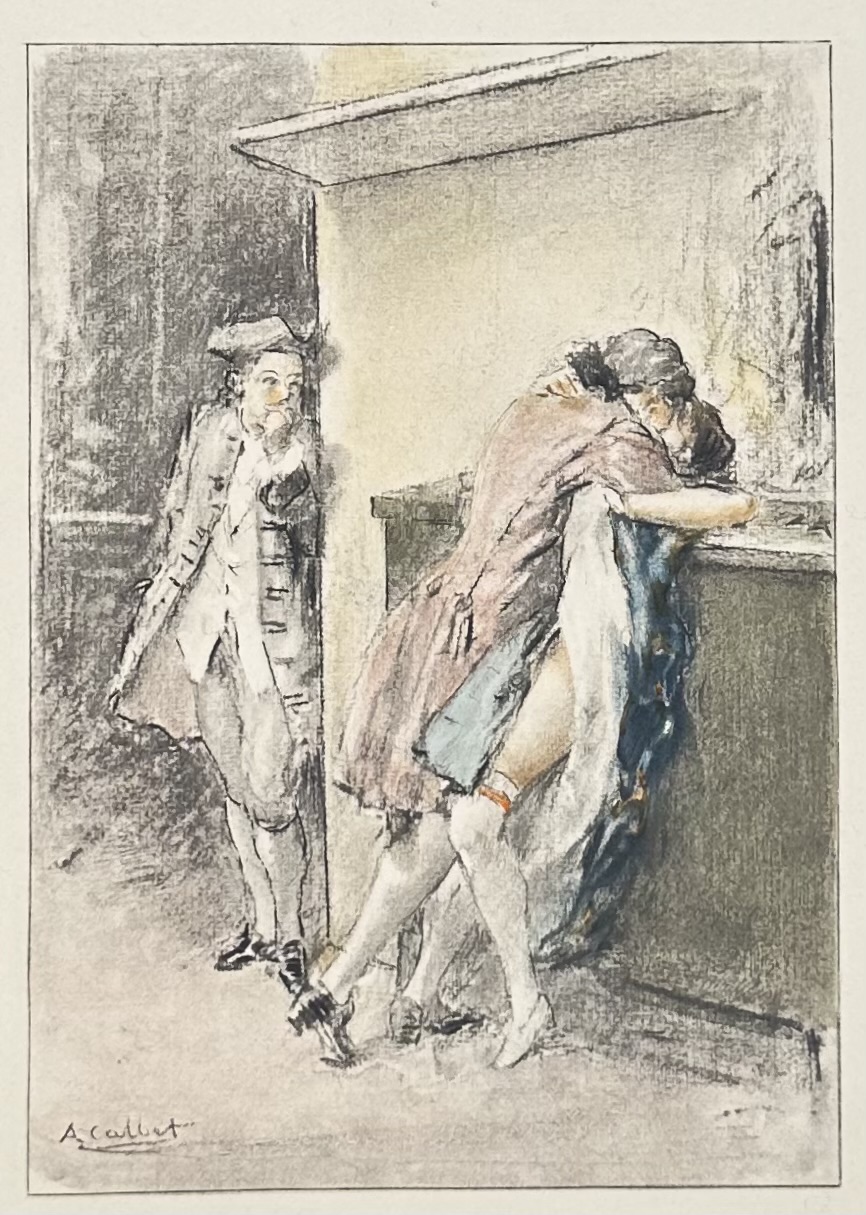
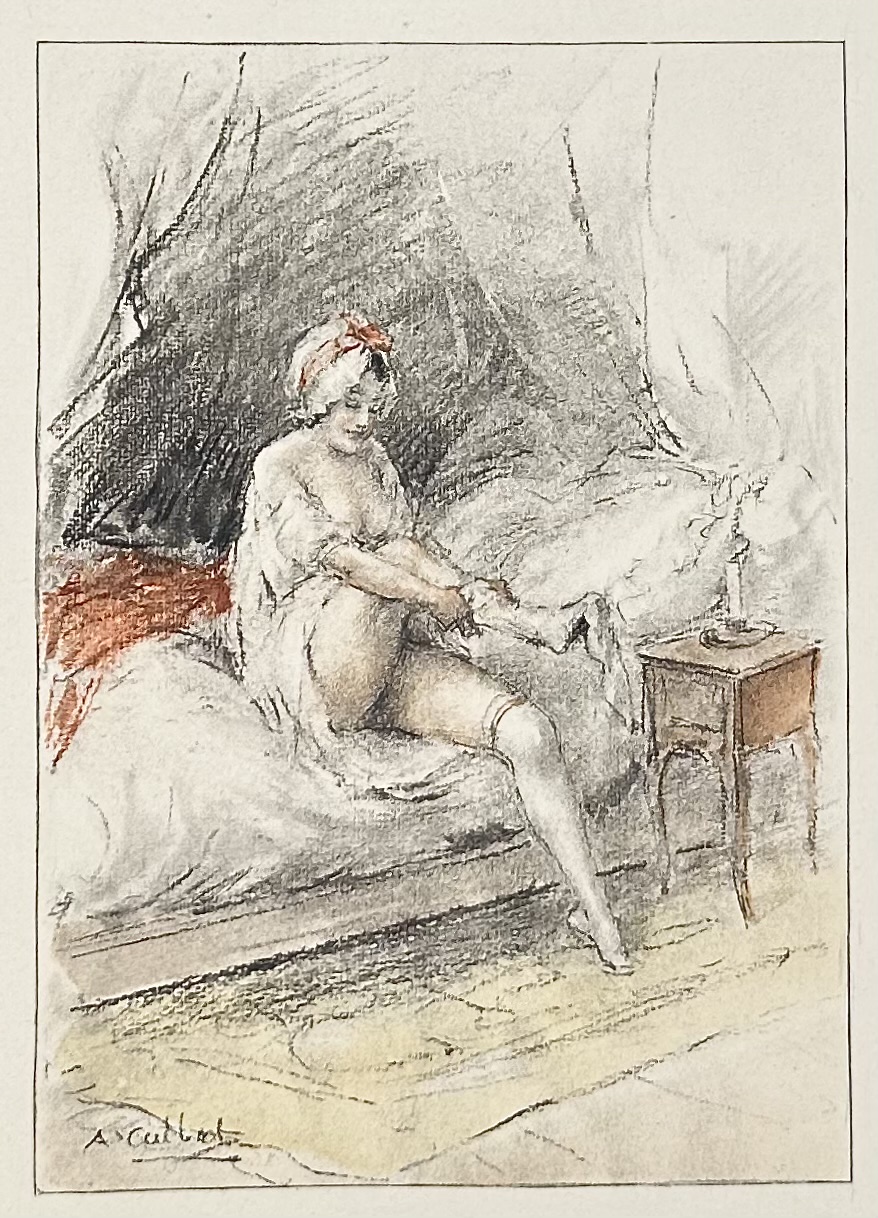 Title-page (red and black): CONTES LIBERTINS | DU DIX-HUITIÈME SIÈCLE | PRÉSENTÉS PAR EDMOND PILON | TRENTE-DEUX ILLUSTRATIONS EN COULEURS | DE | A. CALBET | {fleuron} | PARIS | LE VASSEUR & Cie, ÉDITEURS | 33, Rue de Fleurus ||
Limitation: 587 copies, of which 32 on Japon Impérial (№№ 1-32), 65 on Hollande Van Gilder (№№ 33-97), 490 on Velin a la forme de Rives (№№ 98-587). 25 copies were printed on top of this print run for collaborators, numbered in Roman letters. This copy is № 77 on watermarked Van Gilder Zonnen paper.
Colophon: LE TEXTE DE CET OUVRAGE A | ÉTÉ IMPRIMÉ SUR LES PRESSES | DE CL. JACOUB ET Cie. | LES ILLUSTRATIONS, GRAVÉES PAR L. MACCARD, ONT ÉTÉ | TIRÉES EN TAILLE-DOUCE | PAR A. PORCABEUF ET Cie. | ACHEVÉ D'IMPRIMER, A | PARIS, LE 12 OCTOBRE 1936.
Table of contents:
Histoire de madame Allain – Notice sur le comte de Caylus.
Histoire de Cidal Acmet – Notice sur l'abbé Prevost
Aline, reine de Golconde – Notice sur le chevalier de Boufflers
Cosi-Sancta – notice sur Voltaire.
Cécile, Marine et Bellino – Notice sur Casanova de Seingalt
Histoire de Babet – Notice sur l'abbé Du Laurens
Histoire de Fanny Hill – Notice sur John Cleland.
Louise et Thérèse – Notice sur Rétif de La Bretonne
Contributors:
Pilon, Edmond (French, 1874 – 1945) – compiler
Le Vasseur & Cie – publisher
Calbet, Antoine (French, 1860 – 1942) – artist
Cl. Jacoub et Cie – printer/text
Maccard, Louis (French) – engraver
Porcabeuf, Alfred (French, 1867 – 1952) – printer/plates
Authors:
Caylus, Anne Claude de [comte de Caylus] (French, 1692 – 1765)
Prévost d'Exiles, Antoine François [Abbé Prévost] (French, 1697 – 1763)
Boufflers, Stanislas Jean, chevalier de (French, 1738 – 1815)
Voltaire, François Marie Arouet de (French, 1694 – 1778)
Casanova, Giacomo Girolamo (Italian, 1725 – 1798)
Laurent, Henri-Joseph [Abbé Du Laurens] (French, 1719 – 1793)
Cleland, John (British, c. 1709 – 1789)
Restif [Retif] de la Bretonne, Nicolas Edmé (French, 1734 – 1806)
Title-page (red and black): CONTES LIBERTINS | DU DIX-HUITIÈME SIÈCLE | PRÉSENTÉS PAR EDMOND PILON | TRENTE-DEUX ILLUSTRATIONS EN COULEURS | DE | A. CALBET | {fleuron} | PARIS | LE VASSEUR & Cie, ÉDITEURS | 33, Rue de Fleurus ||
Limitation: 587 copies, of which 32 on Japon Impérial (№№ 1-32), 65 on Hollande Van Gilder (№№ 33-97), 490 on Velin a la forme de Rives (№№ 98-587). 25 copies were printed on top of this print run for collaborators, numbered in Roman letters. This copy is № 77 on watermarked Van Gilder Zonnen paper.
Colophon: LE TEXTE DE CET OUVRAGE A | ÉTÉ IMPRIMÉ SUR LES PRESSES | DE CL. JACOUB ET Cie. | LES ILLUSTRATIONS, GRAVÉES PAR L. MACCARD, ONT ÉTÉ | TIRÉES EN TAILLE-DOUCE | PAR A. PORCABEUF ET Cie. | ACHEVÉ D'IMPRIMER, A | PARIS, LE 12 OCTOBRE 1936.
Table of contents:
Histoire de madame Allain – Notice sur le comte de Caylus.
Histoire de Cidal Acmet – Notice sur l'abbé Prevost
Aline, reine de Golconde – Notice sur le chevalier de Boufflers
Cosi-Sancta – notice sur Voltaire.
Cécile, Marine et Bellino – Notice sur Casanova de Seingalt
Histoire de Babet – Notice sur l'abbé Du Laurens
Histoire de Fanny Hill – Notice sur John Cleland.
Louise et Thérèse – Notice sur Rétif de La Bretonne
Contributors:
Pilon, Edmond (French, 1874 – 1945) – compiler
Le Vasseur & Cie – publisher
Calbet, Antoine (French, 1860 – 1942) – artist
Cl. Jacoub et Cie – printer/text
Maccard, Louis (French) – engraver
Porcabeuf, Alfred (French, 1867 – 1952) – printer/plates
Authors:
Caylus, Anne Claude de [comte de Caylus] (French, 1692 – 1765)
Prévost d'Exiles, Antoine François [Abbé Prévost] (French, 1697 – 1763)
Boufflers, Stanislas Jean, chevalier de (French, 1738 – 1815)
Voltaire, François Marie Arouet de (French, 1694 – 1778)
Casanova, Giacomo Girolamo (Italian, 1725 – 1798)
Laurent, Henri-Joseph [Abbé Du Laurens] (French, 1719 – 1793)
Cleland, John (British, c. 1709 – 1789)
Restif [Retif] de la Bretonne, Nicolas Edmé (French, 1734 – 1806) -
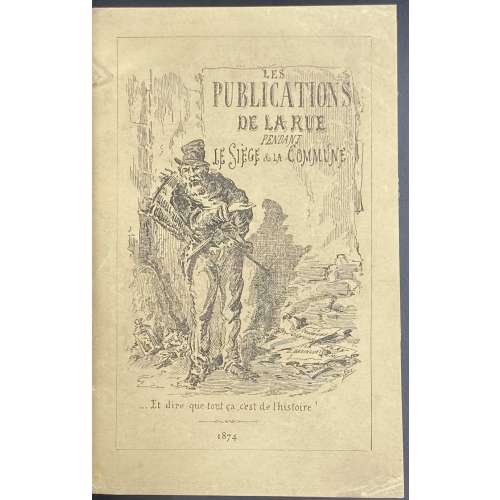 Convolute with three editions, dedicated to the Commune of Paris, 1871. (1) LES | Publications de la Rue | pendant | LE SIEGE ET LA COMMUNE | SATIRES — CANARDS — COMPLAINTES — CHANSONS | PLACARDS ET PAMPHLETS | BIBLIOGRAPHIE | PITTORESQUE ET ANECDOTIQUE | Par Firmin MAILLARD |{publisher’s device}| PARIS | AUGUSTE AUBRY, ÉDITEUR | 18, RUE SÉGUIER, 18 | 1874 || Pagination: ffl, original pictorial wrapper, [2] – blank / advert., [2] – h.t. / blank, [2] – h.t. / colophon imprim. PILLET FILS AINÉ, frontis. similar to front wrapper without '1874', [2] – t.p. / blank, [v] vi-xii, [1] 2-198, three blank leaves, back wrapper. (2) VILLE DE SAINT-DENIS | EXPOSITION D'ART & D'HISTOIRE | La Commune de Paris |18 Mars 1871 28 Mai | AVANT-PROPOS DE Lucien DESCAVES | de l’Académie Goncourt | PREFACE DE Jacques DORIOT | Député de la Seine, Maire de Saint-Denis | Du 17 Mars au 26 Mai 1935 | au Musée Municipal | 4, place de la Légion d’Honneur – Saint-Denis || Pagination: original pictorial wrapper in black and red, frontis., [2] - t.p. / blank, [2] – commité, v-xiii [xiv] 1-113 [114], 26 plates (13 leaves), blank back wrapper, spine tipped-in. (3) J. LEMONNYER | LES | JOURNAUX DE PARIS | PENDANT | LA COMMUNE | REVUE BIBLIOGRAPHIQUE COMPLETE | DE LA PRESSE PARISIENNE | du 19 Mars au 27 Mai | AVEC |{7 lines of text}| ET | UNE TABLE ALPHABÉTIQUE | DONNANT LE PRIX-COURANT DE CHAQUE COLLECTION | PARIS : J. LEMONNYER, Librarire | 73, Rue de Provence, 73 || Pagination: [2] - t.p. / blank, [2] – preface, [7] 8-94, green back wrapper w/advert., bfl. (lacks original front wrapper). Binding: Modern (20th century) red cloth, black label with gilt lettering to spine, matching marbled endpapers. Size: 18.5 x 13 cm; 12mo.
Convolute with three editions, dedicated to the Commune of Paris, 1871. (1) LES | Publications de la Rue | pendant | LE SIEGE ET LA COMMUNE | SATIRES — CANARDS — COMPLAINTES — CHANSONS | PLACARDS ET PAMPHLETS | BIBLIOGRAPHIE | PITTORESQUE ET ANECDOTIQUE | Par Firmin MAILLARD |{publisher’s device}| PARIS | AUGUSTE AUBRY, ÉDITEUR | 18, RUE SÉGUIER, 18 | 1874 || Pagination: ffl, original pictorial wrapper, [2] – blank / advert., [2] – h.t. / blank, [2] – h.t. / colophon imprim. PILLET FILS AINÉ, frontis. similar to front wrapper without '1874', [2] – t.p. / blank, [v] vi-xii, [1] 2-198, three blank leaves, back wrapper. (2) VILLE DE SAINT-DENIS | EXPOSITION D'ART & D'HISTOIRE | La Commune de Paris |18 Mars 1871 28 Mai | AVANT-PROPOS DE Lucien DESCAVES | de l’Académie Goncourt | PREFACE DE Jacques DORIOT | Député de la Seine, Maire de Saint-Denis | Du 17 Mars au 26 Mai 1935 | au Musée Municipal | 4, place de la Légion d’Honneur – Saint-Denis || Pagination: original pictorial wrapper in black and red, frontis., [2] - t.p. / blank, [2] – commité, v-xiii [xiv] 1-113 [114], 26 plates (13 leaves), blank back wrapper, spine tipped-in. (3) J. LEMONNYER | LES | JOURNAUX DE PARIS | PENDANT | LA COMMUNE | REVUE BIBLIOGRAPHIQUE COMPLETE | DE LA PRESSE PARISIENNE | du 19 Mars au 27 Mai | AVEC |{7 lines of text}| ET | UNE TABLE ALPHABÉTIQUE | DONNANT LE PRIX-COURANT DE CHAQUE COLLECTION | PARIS : J. LEMONNYER, Librarire | 73, Rue de Provence, 73 || Pagination: [2] - t.p. / blank, [2] – preface, [7] 8-94, green back wrapper w/advert., bfl. (lacks original front wrapper). Binding: Modern (20th century) red cloth, black label with gilt lettering to spine, matching marbled endpapers. Size: 18.5 x 13 cm; 12mo. -
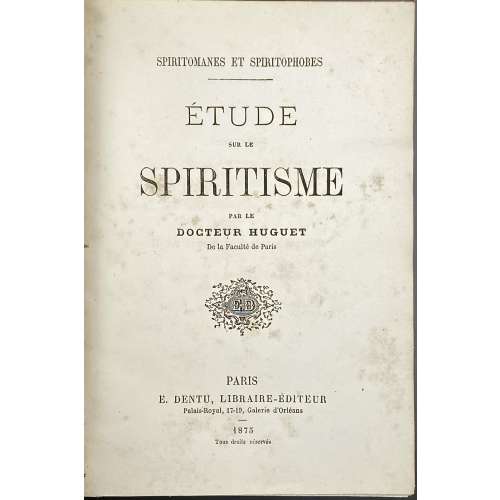 Hardcover volume 20 x 14 cm, bound in burgundy half faux chagrin over brown faux chagrin boards, gilt lettering to spine, marbled endpapers, all margins sprinkled blue. Convolute: 1) SPIRITOMANES ET SPIRITOPHOBES |— | ÉTUDE | SUR LE | SPIRITISME | PAR LE | DOCTEUR HUGUET | De la Faculté de Paris | {« ED » publsiher’s device} | PARIS | E. DENTU, LIBRAIRE-ÉDUTEUR | Palais-Royal, 17-19, Galerie d’Orléans | – | 1875 | Tous droits réservés ||; pp. [1-7] 8-48, with Dr Huguet signature to h.t. verso. Contents: Introduction. I. Le procès du 16 juin 1875; MM. Firman, Buguet, Leymarie. II. Le Spiritisme dans ses rapports avec le dogme, l’histoire, la science. Conclusion. 2) Same, pp. [1-7] 8-48, with Dr Huguet signature to h.t. verso. 3) FÉDÉRATION SPIRITE BELGE | — | Étude critique | DU LIVRE INTITULÉ | L'Hypnotisme | et le Spiritisme | du Docteur Joseph LAPPONI | Médecin de L. L. S. S. LÉON XIII et PIE X. | * | CONFÉRENCE | PAR | J. FRAIKIN | Président de la Fédération Spirite de Liége, | Vice-Président de la Fédération Spirite Belge. | * | Imp. Emile Dumon | Rue Haute-Marexhe, 27, Herstal-Liége. ||; pp. [1-3] 4-50 [51] errata/blank. 4) BUREAU PERMANENT D’ÉTUDE | DES | PHÉNOMÈNES SPIRITES | ANVERS | * | Cours De Doctrine Spirite | — | Imprimerie et Publicité « LA GÉNÉRALE » (SOC. AN.) Anvers. ||; 6 leaves, pagination trimmed out with partly visible numbers 13 and 18 ; includes Deuxième leçon « Du passage de la vie… », t.p., 7 pp. of text, last three pages blank. 5) LA PSYCHOLOGIE EXPERIMENTALE || Manifeste adresse par le « Syndicat de la Presse spiritualiste de France » | au Congres spiritualiste de Londres (Juin 1898); pp. [1] 2-31 [32]. Contents: I. Prolégomènes. II. Télépathie. III. Médiumnité. Conclusion. 6) LE FLUIDE HUMAIN | Son existence/ | Ses lois * Ses propriétés | — | CONFÉRENCE | DONNÉE PAR LE | Sous-Lieutenant DE BACKERE | — ||; pp. [1-3] 4-28. Contributors: Hilarion Huguet (French, ? – ?) Alfred-Henri Firman (American, ? – ?) Édouard Isidore Buguet (1840 – 1901) Pierre-Gaëtan Leymarie (1827 – 1901) Giuseppe Lapponi (Italian, 1851 – 1906) Jacques Fraikin (Belgian, ? – ?) Franz de Backere (Belgian, ? – ?)
Hardcover volume 20 x 14 cm, bound in burgundy half faux chagrin over brown faux chagrin boards, gilt lettering to spine, marbled endpapers, all margins sprinkled blue. Convolute: 1) SPIRITOMANES ET SPIRITOPHOBES |— | ÉTUDE | SUR LE | SPIRITISME | PAR LE | DOCTEUR HUGUET | De la Faculté de Paris | {« ED » publsiher’s device} | PARIS | E. DENTU, LIBRAIRE-ÉDUTEUR | Palais-Royal, 17-19, Galerie d’Orléans | – | 1875 | Tous droits réservés ||; pp. [1-7] 8-48, with Dr Huguet signature to h.t. verso. Contents: Introduction. I. Le procès du 16 juin 1875; MM. Firman, Buguet, Leymarie. II. Le Spiritisme dans ses rapports avec le dogme, l’histoire, la science. Conclusion. 2) Same, pp. [1-7] 8-48, with Dr Huguet signature to h.t. verso. 3) FÉDÉRATION SPIRITE BELGE | — | Étude critique | DU LIVRE INTITULÉ | L'Hypnotisme | et le Spiritisme | du Docteur Joseph LAPPONI | Médecin de L. L. S. S. LÉON XIII et PIE X. | * | CONFÉRENCE | PAR | J. FRAIKIN | Président de la Fédération Spirite de Liége, | Vice-Président de la Fédération Spirite Belge. | * | Imp. Emile Dumon | Rue Haute-Marexhe, 27, Herstal-Liége. ||; pp. [1-3] 4-50 [51] errata/blank. 4) BUREAU PERMANENT D’ÉTUDE | DES | PHÉNOMÈNES SPIRITES | ANVERS | * | Cours De Doctrine Spirite | — | Imprimerie et Publicité « LA GÉNÉRALE » (SOC. AN.) Anvers. ||; 6 leaves, pagination trimmed out with partly visible numbers 13 and 18 ; includes Deuxième leçon « Du passage de la vie… », t.p., 7 pp. of text, last three pages blank. 5) LA PSYCHOLOGIE EXPERIMENTALE || Manifeste adresse par le « Syndicat de la Presse spiritualiste de France » | au Congres spiritualiste de Londres (Juin 1898); pp. [1] 2-31 [32]. Contents: I. Prolégomènes. II. Télépathie. III. Médiumnité. Conclusion. 6) LE FLUIDE HUMAIN | Son existence/ | Ses lois * Ses propriétés | — | CONFÉRENCE | DONNÉE PAR LE | Sous-Lieutenant DE BACKERE | — ||; pp. [1-3] 4-28. Contributors: Hilarion Huguet (French, ? – ?) Alfred-Henri Firman (American, ? – ?) Édouard Isidore Buguet (1840 – 1901) Pierre-Gaëtan Leymarie (1827 – 1901) Giuseppe Lapponi (Italian, 1851 – 1906) Jacques Fraikin (Belgian, ? – ?) Franz de Backere (Belgian, ? – ?) -
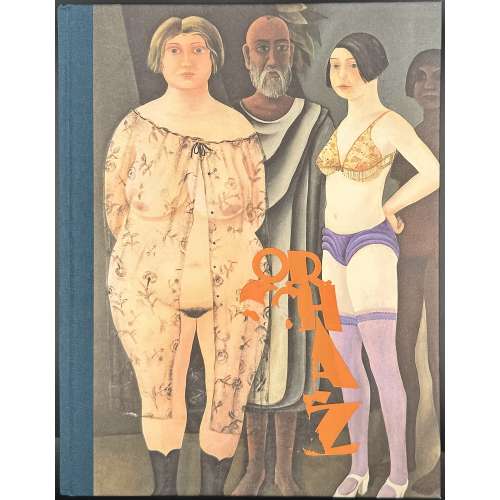 Hardcover, 31 x 24 cm, blue cloth over cardboard, orange lettering to spine, pictorial front cover, embossed back cover, pp.: [1-6] 7-271 [1], approx. 700 colour illustrations. Monograph and catalogue raisonné. ISBN: 978-3-85415-570-6. Title-page (orange): CORNELIA CABUK | {O. R. Schatz as vignette} | MONOGRAFIE | und | WERK= | VERZEICHNIS | mit Textbeiträgen von | STELLA ROLLIG | DIETER KRAFT | CORNELIA CABUK | Belvedere Werkverzeichnisse, Band 7 | Stella Rollig, Christian Huemer (Hg.) || Contributors: Otto Rudolf Schatz (Austrian, 1900 – 1961) Österreichische Galerie Belvedere Cornelia Cabuk Dieter Kraft Stella Rollig Ritter Verlag (Vienna)
Hardcover, 31 x 24 cm, blue cloth over cardboard, orange lettering to spine, pictorial front cover, embossed back cover, pp.: [1-6] 7-271 [1], approx. 700 colour illustrations. Monograph and catalogue raisonné. ISBN: 978-3-85415-570-6. Title-page (orange): CORNELIA CABUK | {O. R. Schatz as vignette} | MONOGRAFIE | und | WERK= | VERZEICHNIS | mit Textbeiträgen von | STELLA ROLLIG | DIETER KRAFT | CORNELIA CABUK | Belvedere Werkverzeichnisse, Band 7 | Stella Rollig, Christian Huemer (Hg.) || Contributors: Otto Rudolf Schatz (Austrian, 1900 – 1961) Österreichische Galerie Belvedere Cornelia Cabuk Dieter Kraft Stella Rollig Ritter Verlag (Vienna) -
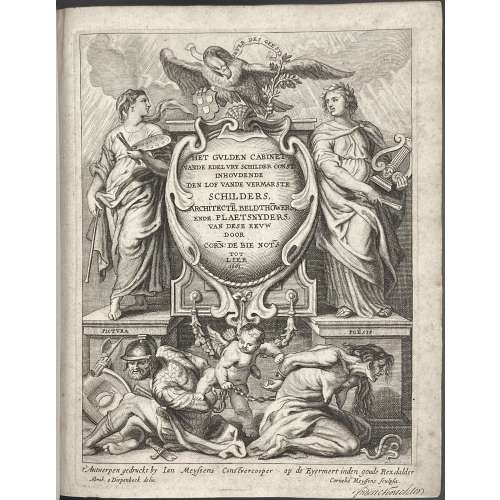 Engraved title page:
Engraved title page:- In an oval cartouche at the centre, flanked by female personifications of Painting and Poetry, surmounted by an eagle, Mars and Envy chained by Cupid below: HET GULDEN CABINET | VANDE EDEL VRY SCHILDER, CONST | INHOUDENDE | DEN LOF VANDE VERMARSTE | SCHILDERS, | ARCHITECTE, BELDTHOWERS | ENDE PLAETSNYDERS | VAN DESE EEVW | DOOR | CORN: DE BIE NOTS. | TOT | LIER | 1661. ||
- In lower margin below the image frame: t’Antwerpen gedruckt by Ian Meyssens Constvercooper op de Eyermert inden goude Rexdalder | Abrah. a Diepenbeck delin. — Cornelis Meyssens sculpsit. || Handwritten inscription below: Frederik Verachter
Cornelis de Bie. Het Gulden Cabinet. — Antwerp: [J. van Montfort for] Jan Meyssens, 1661 [colophon: 1662]. First edition, quarto, with engraved title, added portrait of De Bie dated 1708 mounted and inserted*, illustrated with 97 full-page engravings of artists, and an engraving of a personification of the city of Rome repeated five times; bound in full contemporary Dutch parchment over boards, tooled in blind, titled on spine; ex libris Frederik Verachter (Dutch, 1797 – 1870), archivist of the Antwerp city library, with pages of notes in his hand, signature to title, and inserted leaf with extra biographical information about one of the 280 artists of the Low Countries profiled and illustrated in this volume; contents good; ex libris Gustave Van Havre (Dutch, 1817 – 1892), with his armorial bookplate inside the front board, 24 x 19.5 x 4.5 cm.
Catalogue raisonné: J. F. Van Someren (1888) pp. 200-202. * CORNELIUS DE BIE. ÆT. 81. 1708. | Dat Ick op D'aard Niet Anders Ben | Als Stof En Assen Ick Beken: | En Alle Mijnen Arrebeijd | Noch Van Veel Minder Weerdigheijt. || J. C. de Cock delin: — H. F. diamaer Sculpsit Antv: Ref.: Royal Collection Trust. Backer, Jacob de (Flemish, c. 1555 – c. 1585) (artist) Balen, Jan van (Flemish, 1611 – 1654) (artist) Bally, David (Dutch, 1584 – 1657) (artist) Beck, David [Beek] (Dutch, 1621 – 1656) (artist) Bie, Cornelis de (Flemish, 1627 – 1711) (author) Bloemaert, Abraham (Dutch, 1565 – 1658) (artist) Borcht I, Hendrik van der, the Elder (Flemish, 1583 – 1651) (artist) Borcht II, Hendrik van der, the Younger (German 1614 – 1676) (artist) Bouttats, Frederik, the Elder (Flemish, 1590 – 1661) (attributed to) (engraver) Bramer, Leonard [Leendert] (Dutch, 1596 – 1674) (artist) Bronckhorst, Jan Gerritsz van (Dutch, 1603-1661) (artist) Bylert, Jan van (Dutch, 1603 – 1671) (artist) Caukercken, Cornelis van (Flemish, 1626 – 1680) (engraver) Collin, Richard (Luxembourgish, 1627 – 1698) (engraver) Coques, Gonzales (Flemish, 1614 – 1684) (artist) Cossiers, Joannes (Flemish, 1600 – 1671) (artist) Danckerts de Rij, Peter (Dutch, 1605-1660) (artist) Dipenbeeck, Abraham van (Dutch, 1596 – 1675) (artist) Does, Antony van der (Flemish, 1609 –1680) (engraver) Dyck, Anthony van (Flemish, 1599 – 1641) (artist) François, Pierre (fl. 1643) (artist) Hecke, Jan van den, the Elder (Flemish, 1620 – 1684) (engraver) Heil, Daniel van (Flemish, 1604 – 1664) (artist) Heil, Jan Baptiste van (Flemish, 1609 – 1685) (artist) Heil, Leo van (Flemish, 1605 – c. 1664) (artist) Helt Stockade, Nicolaes van (Dutch, 1614 – 1669) (artist) Hollar, Wenceslaus [Hollar, Václav; Wenzel] ( Bohemian, 1607 – 1677) (artist) Hondius I, Hendrick [de Hondt] (Flemish-Dutch, 1573 – 1650) (artist) Janssens, Cornelis van Ceulen [Johnson, Cornelius] (Flemish-Dutch, 1593-1664) (artist) Jode I, Pieter de, the Elder (1570 – 1634) (engraver) Jordaens, Jacob (Flemish, 1593 – 1678) (artist) Lint, Peter van (Flemish, 1609 – 1690) (artist) Meyssens, Cornelis (Flemish, 1639 – fl.1673) (engraver) Meyssens, Joannes [Johannes, Jan, Jean] (Flemish, 1612 – 1670) Mola, Pier Francesco (Italian, 1612 – 1666) (artist) Monte, Deodat del [Mont, Deodat van der; Delmont, Deodatus] (Flemish, 1582 – 1644) (artist) Montfort, Jan van (fl. c. 1595 – 1644) (printer) Padoanino, Francisco (Italian, 1660) (artist) Poelenburgh, Cornelis van [Poelenburch] (Dutch, 1594 – 1667) (artist) Pontius, Paulus (Flemish, 1603 – 1658) (engraver) Quellinus, Erasmus, the Younger (Flemish, 1607 – 1678) (artist) Reni, Guido (Italian, 1575 – 1642) (artist) Sadeler II, Egidius (Flemish, c.1570 – 1629) (artist) Saftleven, Herman, the Younger (Dutch, 1609 – 1685) (artist) Seghers, Gerard (Flemish, 1591 - 1651) (artist) Snyers, Hendrik (Flemish, 1611 – 1644) (engraver) Soutman, Pieter Claesz (Dutch, 1593/1601 – 1657) (artist) Steen, Franciscus van der (Flemish, 1625 – 1672) (engraver) Teniers, David, the Younger (Flemish, 1610 – 1690) (artist) Venne, Adriaen van de [Adriaen Pietersz] (Dutch, 1589 – 1662) (artist) Voet, Alexander, the Elder (Flemish, 16-8/1613 – 1689) (engraver) Vorsterman, Lucas, the Elder (Flemish, 1595-1675) (engraver) Waumans, Conraed (Flemish, 1619 – 1675) (engraver) Willaerts, Adam (Dutch, 1577 – 1664) (artist) -
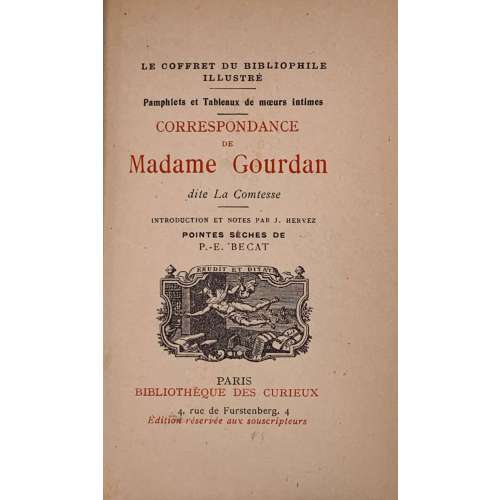 Front wrapper and title-page (in red and black): LE COFFRET DU BIBLIOPHILE ILLUSTRE | Pamphlets et Tableaux de mœurs intimes | CORRESPONDANCE | DE | Madame Gourdan | dite La Comtesse | INTRODUCTION ET NOTES PAR J. HERVEZ. | POINTES SÈCHES DE | P.-E. BECAT | {device} | PARIS | BIBLIOTHÈQUE DES CURIEUX | 4, rue de Furstenberg, 4 | Édition réservée aux souscripteurs || Limitation: L'édition illustrée du "Coffret | du bibliophile" est tirée à 750 | exemplaires, sur vergé de Rives, | – numérotés de 1 à 750 – | № 353 || Limited edition of 750 copies on Rives laid paper, of which this is copy № 353. Collation: fep, 3 blanks, front wrapper, 3 blanks vergé, [2] h.t. / limit., [2] t.p., [5] 6-188, blank, back wrapper, 3 blanks, fep., plus 12 plates, dry-points by P.-É. Bécat, extraneous to collation, incl. frontispiece. Binding: 16 x 10.3 cm, red crushed morocco, gilt lettering to spine, marbled endpapers, printed on laid paper, original wrappers preserved. Contributors: Marguerite Gourdan [Marguerite Alexandrine Ernestine Stock] (French, c. 1730 –1783) – fictional author. Jean Hervez (French, 1864 – ?) – author (preface). Charles Théveneau de Morande (French, 1741 – 1805) – presumable author of the text. Paul-Émile Bécat (French, 1885 – 1960) – artist. Bibliothèque des curieux [Georges & Robert Briffaut], Georges Briffaut (French, 1886 – 1973) – publisher. Previous editions: First published 1783, under the title: "Le portefeuille de Madame Gourdan" in London by Jean Nourse. Bibliothèque des curieux, 1910. Bibliothèque des curieux, 1924.
Front wrapper and title-page (in red and black): LE COFFRET DU BIBLIOPHILE ILLUSTRE | Pamphlets et Tableaux de mœurs intimes | CORRESPONDANCE | DE | Madame Gourdan | dite La Comtesse | INTRODUCTION ET NOTES PAR J. HERVEZ. | POINTES SÈCHES DE | P.-E. BECAT | {device} | PARIS | BIBLIOTHÈQUE DES CURIEUX | 4, rue de Furstenberg, 4 | Édition réservée aux souscripteurs || Limitation: L'édition illustrée du "Coffret | du bibliophile" est tirée à 750 | exemplaires, sur vergé de Rives, | – numérotés de 1 à 750 – | № 353 || Limited edition of 750 copies on Rives laid paper, of which this is copy № 353. Collation: fep, 3 blanks, front wrapper, 3 blanks vergé, [2] h.t. / limit., [2] t.p., [5] 6-188, blank, back wrapper, 3 blanks, fep., plus 12 plates, dry-points by P.-É. Bécat, extraneous to collation, incl. frontispiece. Binding: 16 x 10.3 cm, red crushed morocco, gilt lettering to spine, marbled endpapers, printed on laid paper, original wrappers preserved. Contributors: Marguerite Gourdan [Marguerite Alexandrine Ernestine Stock] (French, c. 1730 –1783) – fictional author. Jean Hervez (French, 1864 – ?) – author (preface). Charles Théveneau de Morande (French, 1741 – 1805) – presumable author of the text. Paul-Émile Bécat (French, 1885 – 1960) – artist. Bibliothèque des curieux [Georges & Robert Briffaut], Georges Briffaut (French, 1886 – 1973) – publisher. Previous editions: First published 1783, under the title: "Le portefeuille de Madame Gourdan" in London by Jean Nourse. Bibliothèque des curieux, 1910. Bibliothèque des curieux, 1924. -
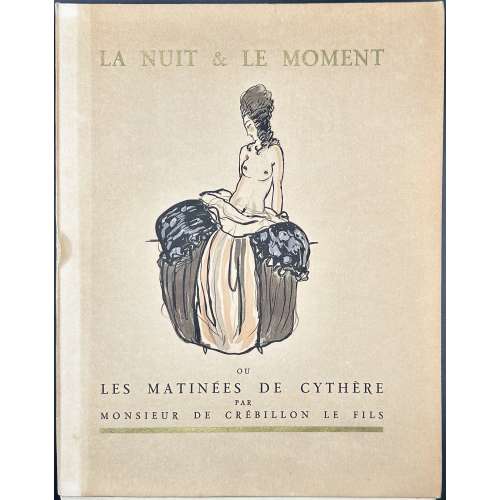 Softcover volume, 33 x 26 cm, collated in folio, not bound, in publisher’s French flapped pictorial wrappers, lettering to spine; printed on thick wove Arches paper watermarked “MBM”, upper edge trimmed, owner’s blind stamp to h.t. “Ex Libris Comte Tony de Vibraye”, glassine dust jacket, in a slipcase. Collation: π2 1-262, total 54 leaves, plus 4 leaves in wrappers, plus 10 plates, incl. frontispiece; coloured aquatints after Sylvain Sauvage; coloured etched vignette to front wrapper, gilt woodcut to back wrapper, woodcut title-page and woodcut headpiece after the same. Pp.: [4] [1] 2-102 [2]. Front wrapper (gilt and black): LA NUIT & LE MOMENT | {vignette} | OU | LES MATINÉES DE CYTHÈRE | PAR | MONSIEUR DE CRÉBILLON LE FILS | — || Title-page (woodcut): CRÉBILLON LE FILS | — | LA NUIT ET LE MOMENT | OU | LES MATINÉES | DE CYTHÈRE | {vignette} | A PARIS | AUX DEPENS D'UN AMATEUR | — | M CM XXIV || Limitation: De cette édition il a été tiré un exemplaire unique sur japon impérial comportant dix aquarelles originales, deux cents trente exemplaires sur vélin d' Arches numérotés 1 à 230, dont les dix premiers avec une suite de hors texte sur japon. N° 1 [Print run limited to 230 copies on Arches plus a unique copy on Japon with original watercolours, this is copy № 1 on wove paper]. Seller’s description: La Nuit et le moment ou Les Matinées de Cythère. Paris, Au dépens d'un amateur, 1924. In-4, en feuilles, non rogné, couverture illustrée et étui. Ouvrage illustré de 4 gravures sur bois et de 10 eaux-fortes libres en couleurs hors texte de Sylvain Sauvage. Tirage à 231 exemplaires, celui-ci le n°1 sur vélin d'Arches. Manque la suite de hors texte sur japon. De la bibliothèque du Comte Tony de Vibraye, avec cachet à froid. Dutel, n°2062. Catalogue raisonné: honesterotica.com; Dutel III 2062. Contributors: Claude-Prosper Jolyot de Crébillon [Crébillon fils] (French, 1707 – 1777) – author. Sylvain Sauvage [Félix Roy] (French, 1888 – 1948) – artist. Provenance: Antoine Henri Gaston Hurault de Vibraye [Comte Tony de Vibraye] (French, 1893 – 1951)
Softcover volume, 33 x 26 cm, collated in folio, not bound, in publisher’s French flapped pictorial wrappers, lettering to spine; printed on thick wove Arches paper watermarked “MBM”, upper edge trimmed, owner’s blind stamp to h.t. “Ex Libris Comte Tony de Vibraye”, glassine dust jacket, in a slipcase. Collation: π2 1-262, total 54 leaves, plus 4 leaves in wrappers, plus 10 plates, incl. frontispiece; coloured aquatints after Sylvain Sauvage; coloured etched vignette to front wrapper, gilt woodcut to back wrapper, woodcut title-page and woodcut headpiece after the same. Pp.: [4] [1] 2-102 [2]. Front wrapper (gilt and black): LA NUIT & LE MOMENT | {vignette} | OU | LES MATINÉES DE CYTHÈRE | PAR | MONSIEUR DE CRÉBILLON LE FILS | — || Title-page (woodcut): CRÉBILLON LE FILS | — | LA NUIT ET LE MOMENT | OU | LES MATINÉES | DE CYTHÈRE | {vignette} | A PARIS | AUX DEPENS D'UN AMATEUR | — | M CM XXIV || Limitation: De cette édition il a été tiré un exemplaire unique sur japon impérial comportant dix aquarelles originales, deux cents trente exemplaires sur vélin d' Arches numérotés 1 à 230, dont les dix premiers avec une suite de hors texte sur japon. N° 1 [Print run limited to 230 copies on Arches plus a unique copy on Japon with original watercolours, this is copy № 1 on wove paper]. Seller’s description: La Nuit et le moment ou Les Matinées de Cythère. Paris, Au dépens d'un amateur, 1924. In-4, en feuilles, non rogné, couverture illustrée et étui. Ouvrage illustré de 4 gravures sur bois et de 10 eaux-fortes libres en couleurs hors texte de Sylvain Sauvage. Tirage à 231 exemplaires, celui-ci le n°1 sur vélin d'Arches. Manque la suite de hors texte sur japon. De la bibliothèque du Comte Tony de Vibraye, avec cachet à froid. Dutel, n°2062. Catalogue raisonné: honesterotica.com; Dutel III 2062. Contributors: Claude-Prosper Jolyot de Crébillon [Crébillon fils] (French, 1707 – 1777) – author. Sylvain Sauvage [Félix Roy] (French, 1888 – 1948) – artist. Provenance: Antoine Henri Gaston Hurault de Vibraye [Comte Tony de Vibraye] (French, 1893 – 1951) -
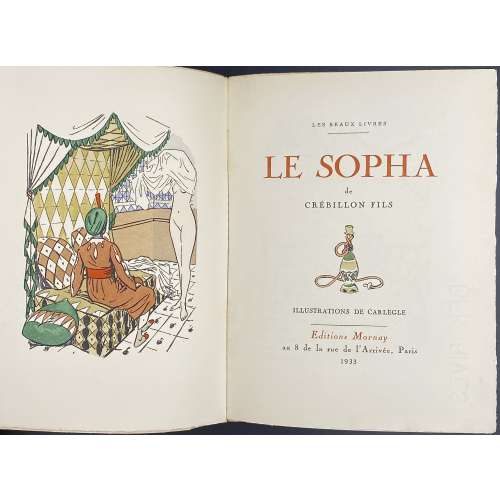 Title: LES BEAUX LIVRES | — | LE SOPHA | de | CRÉBILLON FILS |{vignette}| ILLUSTRATIONS DE CARLÈGLE | — | Éditions Mornay | au 8 de la rue de l’Arrivée, Paris | 1933 || Series: Les beaux livres Binding: Original pictorial wrappers, margins untrimmed, uncut; printed on BFK Rives paper (watermark); the number of copy blacked out. Justification of the print run on p. [329].Pagination: [1-8] 9-326 [327-331], ill., woodcuts in text. Size: 20.2 x 15.5 cm
Title: LES BEAUX LIVRES | — | LE SOPHA | de | CRÉBILLON FILS |{vignette}| ILLUSTRATIONS DE CARLÈGLE | — | Éditions Mornay | au 8 de la rue de l’Arrivée, Paris | 1933 || Series: Les beaux livres Binding: Original pictorial wrappers, margins untrimmed, uncut; printed on BFK Rives paper (watermark); the number of copy blacked out. Justification of the print run on p. [329].Pagination: [1-8] 9-326 [327-331], ill., woodcuts in text. Size: 20.2 x 15.5 cm -
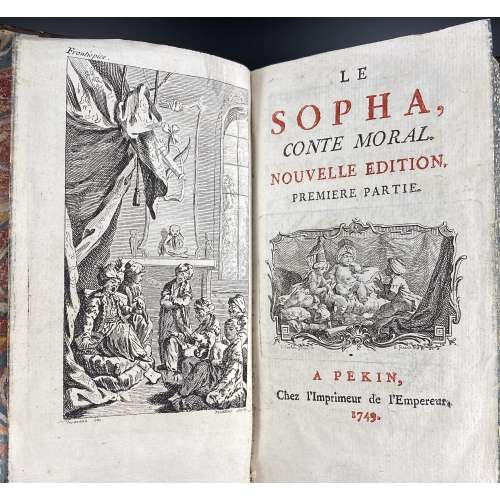 Title-page in black and red: LE | SOPHA, | CONTE MORAL. | NOUVELLE EDITION. | PREMIERE PARTIE. | {vignette} | A PEKIN, | Chez l'imprimeur de l'Empereur, | 1749. || Pagination: Two volumes in one. [2] – blanks, [2] – blank / frontis., [i, ii] – t.p. / blank, [iii] iv-xxi [xxii] ; [1] 2-253, [254-256] – table / blank, [2] – blanks; [i, ii] f.t. (seconde partie). [iii] 4-237 [238-240] – table / blank, [2] – blanks ; ills. 1 frontispiece, 4 plates and 2 vignettes by Pelletier after Clavereau, 2 fleurons by Fessard after Cochin. Collation: 12mo; a12, A8B4–T8V4, X8 [*1]; A8B4–T8V4. Binding: Full mottled calf, flat spine, compartments double-ruled in gilt, gilt flowers and foliage in compartments, crimson title label; marbled endpapers. Printed on laid paper, watermarked. Size: 14.8 x 8.8 cm Catalogue raisonné: Cohen, de Ricci (266); J. Lewine (124-5).
Title-page in black and red: LE | SOPHA, | CONTE MORAL. | NOUVELLE EDITION. | PREMIERE PARTIE. | {vignette} | A PEKIN, | Chez l'imprimeur de l'Empereur, | 1749. || Pagination: Two volumes in one. [2] – blanks, [2] – blank / frontis., [i, ii] – t.p. / blank, [iii] iv-xxi [xxii] ; [1] 2-253, [254-256] – table / blank, [2] – blanks; [i, ii] f.t. (seconde partie). [iii] 4-237 [238-240] – table / blank, [2] – blanks ; ills. 1 frontispiece, 4 plates and 2 vignettes by Pelletier after Clavereau, 2 fleurons by Fessard after Cochin. Collation: 12mo; a12, A8B4–T8V4, X8 [*1]; A8B4–T8V4. Binding: Full mottled calf, flat spine, compartments double-ruled in gilt, gilt flowers and foliage in compartments, crimson title label; marbled endpapers. Printed on laid paper, watermarked. Size: 14.8 x 8.8 cm Catalogue raisonné: Cohen, de Ricci (266); J. Lewine (124-5). -
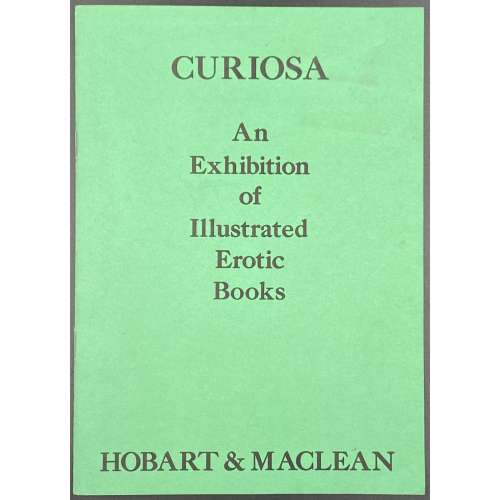 Title: CURIOSA | An | Exhibition | of | Illustrated | Erotic | Books | HOBART & MACLEAN || Pagination: 16 unpaginated pages with bibliography of 49 editions with prices and 51 images. Stapled softcover, original green wrappers with lettering to front and illustration to back. Size: 21 x 15 cm.
Title: CURIOSA | An | Exhibition | of | Illustrated | Erotic | Books | HOBART & MACLEAN || Pagination: 16 unpaginated pages with bibliography of 49 editions with prices and 51 images. Stapled softcover, original green wrappers with lettering to front and illustration to back. Size: 21 x 15 cm. -
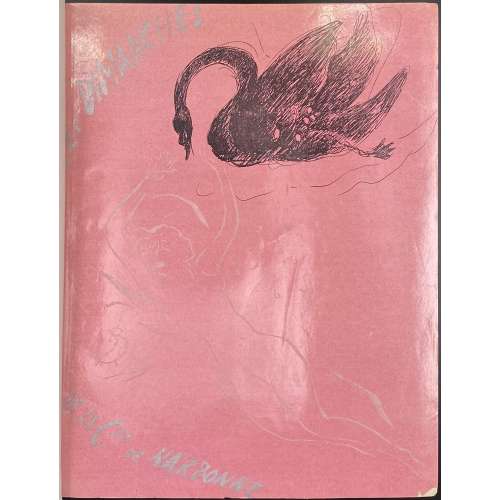 Description: Bound in brown ¾ morocco over marbled boards by R. et R. Mativet (ink stamp to ffep verso), collated 4to, 26.4 x 20.7 cm, raised bands, gilt arabesque and lettering to spine, original glossy pink pictorial wrappers preserved, marbled endpapers, bookplate to front pastedown “ML”, to front fep “EX-LIBRIS | Jacques | Crépineau”; A.L.s. of Marcel Vertès pasted to one of the feps: "Biblis [6] rue Jacques Callot. Cher Monsieur Le Bodo, Voudriez-vous avoir l’amabilité et de céder un exemplaire de « Dimanche » à M. Risler à un prix très réduit? Merci d’avance. Bien à vous, Vertès". Jean Le Bodo – abord gérant de la Librairie Biblis (20, rue du Vieux-Colombier, Paris 6e), et en 1946, libraire au Livre de France, Paris 16e; Risler – probablement Jean-François Risler (1910-1952), fils d’un pianiste Joseph-Édouard Risler (1873 – 1929). Title-page: DAISY FELLOWES | Les | Dimanches | de la | Csse de Narbonne | ILLUSTRATIONS | DE | VERTÈS | ÉDITIONS DE France | 20, AVENUE RAPP, PARIS || Collation: 1 blank, front wrapper, π4 (2 blanks with A.L.s. pasted to the 2nd, h.t., t.p.), 1-244 χ4 (table, colophon, 2 blanks) back wrapper, 1 blank; total 104 leaves within the wrappers, numerous in-text and 7 full-page prints after drawings by Marcel Vertès, within collation. Pagination: [8] [1-2] 3-191 [192] [8], total 208 pages, ils. Limitation: printed on June 25, 1935 by Coulouma (Argenteuil) under the direction of H. Barthélemy, 20 copies (№1-20) on Japon blanc super-nacré + two suites, 80 copies on Japon a la forme (№21-100) + one suite, 900 (№101-1000) on Vélin blanc. This is copy № 598. Catalogue raisonné: Vokaer (Vertès) № 34, p. 15. Provenance: Jacques Crepineau (French, 1932 – 2017). Contributors: Daisy Fellowes [Marguerite Séverine Philippine Decazes de Glücksberg] (French, 1890 – 1962) – author Marcel Vertès [Marcell Vértes] (Jewish-Hungarian-French, 1895 – 1961) – artist.
Description: Bound in brown ¾ morocco over marbled boards by R. et R. Mativet (ink stamp to ffep verso), collated 4to, 26.4 x 20.7 cm, raised bands, gilt arabesque and lettering to spine, original glossy pink pictorial wrappers preserved, marbled endpapers, bookplate to front pastedown “ML”, to front fep “EX-LIBRIS | Jacques | Crépineau”; A.L.s. of Marcel Vertès pasted to one of the feps: "Biblis [6] rue Jacques Callot. Cher Monsieur Le Bodo, Voudriez-vous avoir l’amabilité et de céder un exemplaire de « Dimanche » à M. Risler à un prix très réduit? Merci d’avance. Bien à vous, Vertès". Jean Le Bodo – abord gérant de la Librairie Biblis (20, rue du Vieux-Colombier, Paris 6e), et en 1946, libraire au Livre de France, Paris 16e; Risler – probablement Jean-François Risler (1910-1952), fils d’un pianiste Joseph-Édouard Risler (1873 – 1929). Title-page: DAISY FELLOWES | Les | Dimanches | de la | Csse de Narbonne | ILLUSTRATIONS | DE | VERTÈS | ÉDITIONS DE France | 20, AVENUE RAPP, PARIS || Collation: 1 blank, front wrapper, π4 (2 blanks with A.L.s. pasted to the 2nd, h.t., t.p.), 1-244 χ4 (table, colophon, 2 blanks) back wrapper, 1 blank; total 104 leaves within the wrappers, numerous in-text and 7 full-page prints after drawings by Marcel Vertès, within collation. Pagination: [8] [1-2] 3-191 [192] [8], total 208 pages, ils. Limitation: printed on June 25, 1935 by Coulouma (Argenteuil) under the direction of H. Barthélemy, 20 copies (№1-20) on Japon blanc super-nacré + two suites, 80 copies on Japon a la forme (№21-100) + one suite, 900 (№101-1000) on Vélin blanc. This is copy № 598. Catalogue raisonné: Vokaer (Vertès) № 34, p. 15. Provenance: Jacques Crepineau (French, 1932 – 2017). Contributors: Daisy Fellowes [Marguerite Séverine Philippine Decazes de Glücksberg] (French, 1890 – 1962) – author Marcel Vertès [Marcell Vértes] (Jewish-Hungarian-French, 1895 – 1961) – artist. -
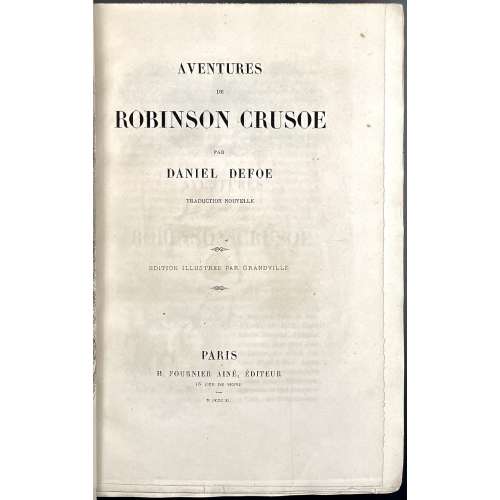 Title page: AVENTURES | DE | ROBINSON CRUSOE | PAR | DANIEL DEFOE | TRADUCTION NOUVELLE | ☙ |EDITION ILLUSTREE PAR GRANDVILLE | ❧ |PARIS | H. FOURNIER AINÉ, ÉDITEUR | 16 RUE DE SEINE | — | M DCCC XL || {sic: no accents in EDITION ILLUSTREE) Pagination: [4] [1]-610, [2] [1]-4., 620 pp. total plus 82 leaves of plates, unpaginated. Collation: 2 binder’s blank leaves, front publisher’s wrapper, h.t / imprint, 2 copies of engraved frontispiece on china paper, t.p. / blank, etc., … text..., back wrapper and spine bound in; 4to: π2 [1]-774 (310 leaves total) plus 40 x 2 plates extraneous to collation. Illustrations: 2 head- and 2 tailpieces, 2 initials, 159 vignettes, and 40 lettered plates each in two variants: one printed on a regular page, and one printed on India paper and pasted to a page. Page size: 24 x 15 cm. Frontispiece: Cut on wood by Louis-Henri Brevière after J. J. Grandville and Français. “Robinson sits on a throne-like chair framed by exotic palm trees. The sculptural and quasi-royal representation of Robinson is flanked by his faithful dog and parrot. The hero’s tools (the gun and the axe) are prominently displayed. He looks to the horizon away to the left, rather than to the tiny ship that can be seen on the horizon. His overcoming of life’s difficult events is at the core of the representation. The massive plinth reinforces the aura of the hero, as do the tiny people admiring the sculpture and learning about the heroic figure. Friday is discreetly represented in a medallion on the plinth along with other decorations including goats and a «savage»". [Sitzia, E. (2020). Lost in Intersemiotic Translation? J.J. Grandville’s Illustration of Robinson Crusoe. Journal for Literary and Intermedial Crossings, 5(2). https://clic.research.vub.be/sites/default/files/atoms/files/SITZIA_FIN.pdf] The monument has an inscription: “ FERNAND | SUEZ” which we deciphered as either a tribute to Juan Fernández (Spanish, c. 1536 – c. 1604) or as a mention of the place where Crusoe’s adventures took place: Archipiélago Juan Fernández to which Isla Róbinson Crusoe belongs. Binding: 24.8 x 16.4 cm, by Emile Mercier, half green crushed morocco over marbled boards, gilt-ruled, spine ornately gilt, sunned to orange tone, marbled endpapers, publisher's pale yellow wrappers bound in; only the top edge trimmed. Contributors: Daniel Defoe (British, 1660 – 1731) – author. J. J. Grandville [Gèrard, Isidore-Adolphe] (French, 1803 – 1847) – artist. François-Louis Français (French, 1814 – 1897) – artist (frontispiece, landscapes). Engravers: John Quartley (British, fl. 1835 – 1867) Matthew Urlwin Sears (British, 1799 – 1870) Adolphe Best (French, 1808 – 1860) One of the Guillaumots: Eugène Guillaumot (French, Paris 1813–1869), or Auguste Etienne Guillaumot (French,1844 – 1890), or his father Auguste-Alexandre Guillaumot (French, 1815 – 1892) Laisné [Alfred, Adèle, and Aglaé] (French, active 1835–1868) Antoine-Alphée Piaud (French, 1813 – 1867) Louis Dujardin (French, 1808 – 1859) A. Hans (nothing is known) Jean Louis Joseph Camille Lacoste (French, 1809 – 1866) Louis-Henri Brevière (French, 1797 – 1869) – vignettes. Provenance: Bishop, Cortlandt Field (American, 1870 – 1935) – bookplate; Mary S. Collins – bookplate by J. H. Fincken Robin F. Satinsky (American, 1919 – 2008) – Robin Collection bookplate. Catalogue raisonné: Brivois (1883) p. 155; Ray (French): № 193, p. 272; Carteret (1927): p. 241. All indicated in-8vo, which doesn't correspond to our in-4to copy.
Title page: AVENTURES | DE | ROBINSON CRUSOE | PAR | DANIEL DEFOE | TRADUCTION NOUVELLE | ☙ |EDITION ILLUSTREE PAR GRANDVILLE | ❧ |PARIS | H. FOURNIER AINÉ, ÉDITEUR | 16 RUE DE SEINE | — | M DCCC XL || {sic: no accents in EDITION ILLUSTREE) Pagination: [4] [1]-610, [2] [1]-4., 620 pp. total plus 82 leaves of plates, unpaginated. Collation: 2 binder’s blank leaves, front publisher’s wrapper, h.t / imprint, 2 copies of engraved frontispiece on china paper, t.p. / blank, etc., … text..., back wrapper and spine bound in; 4to: π2 [1]-774 (310 leaves total) plus 40 x 2 plates extraneous to collation. Illustrations: 2 head- and 2 tailpieces, 2 initials, 159 vignettes, and 40 lettered plates each in two variants: one printed on a regular page, and one printed on India paper and pasted to a page. Page size: 24 x 15 cm. Frontispiece: Cut on wood by Louis-Henri Brevière after J. J. Grandville and Français. “Robinson sits on a throne-like chair framed by exotic palm trees. The sculptural and quasi-royal representation of Robinson is flanked by his faithful dog and parrot. The hero’s tools (the gun and the axe) are prominently displayed. He looks to the horizon away to the left, rather than to the tiny ship that can be seen on the horizon. His overcoming of life’s difficult events is at the core of the representation. The massive plinth reinforces the aura of the hero, as do the tiny people admiring the sculpture and learning about the heroic figure. Friday is discreetly represented in a medallion on the plinth along with other decorations including goats and a «savage»". [Sitzia, E. (2020). Lost in Intersemiotic Translation? J.J. Grandville’s Illustration of Robinson Crusoe. Journal for Literary and Intermedial Crossings, 5(2). https://clic.research.vub.be/sites/default/files/atoms/files/SITZIA_FIN.pdf] The monument has an inscription: “ FERNAND | SUEZ” which we deciphered as either a tribute to Juan Fernández (Spanish, c. 1536 – c. 1604) or as a mention of the place where Crusoe’s adventures took place: Archipiélago Juan Fernández to which Isla Róbinson Crusoe belongs. Binding: 24.8 x 16.4 cm, by Emile Mercier, half green crushed morocco over marbled boards, gilt-ruled, spine ornately gilt, sunned to orange tone, marbled endpapers, publisher's pale yellow wrappers bound in; only the top edge trimmed. Contributors: Daniel Defoe (British, 1660 – 1731) – author. J. J. Grandville [Gèrard, Isidore-Adolphe] (French, 1803 – 1847) – artist. François-Louis Français (French, 1814 – 1897) – artist (frontispiece, landscapes). Engravers: John Quartley (British, fl. 1835 – 1867) Matthew Urlwin Sears (British, 1799 – 1870) Adolphe Best (French, 1808 – 1860) One of the Guillaumots: Eugène Guillaumot (French, Paris 1813–1869), or Auguste Etienne Guillaumot (French,1844 – 1890), or his father Auguste-Alexandre Guillaumot (French, 1815 – 1892) Laisné [Alfred, Adèle, and Aglaé] (French, active 1835–1868) Antoine-Alphée Piaud (French, 1813 – 1867) Louis Dujardin (French, 1808 – 1859) A. Hans (nothing is known) Jean Louis Joseph Camille Lacoste (French, 1809 – 1866) Louis-Henri Brevière (French, 1797 – 1869) – vignettes. Provenance: Bishop, Cortlandt Field (American, 1870 – 1935) – bookplate; Mary S. Collins – bookplate by J. H. Fincken Robin F. Satinsky (American, 1919 – 2008) – Robin Collection bookplate. Catalogue raisonné: Brivois (1883) p. 155; Ray (French): № 193, p. 272; Carteret (1927): p. 241. All indicated in-8vo, which doesn't correspond to our in-4to copy. -
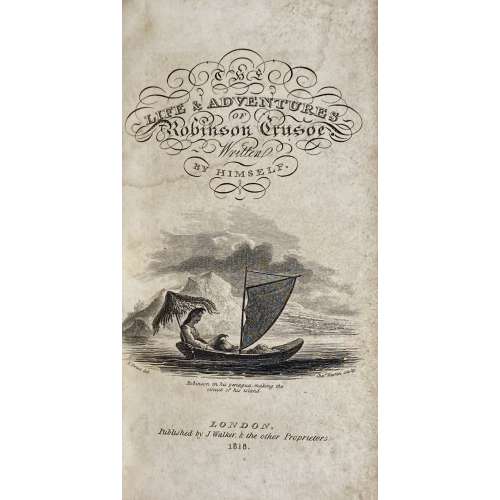 Description: 12mo, full calf, 12.9 x 7.4 cm, boards chain-bordered in gilt, front board gilt-lettered with the name of the owner “T. D. TOWNSEND”, flat spine, adorned in gilt, black label with gilt lettering, red endpapers, bookstore ticket to front pastedown: SOLD BY | ASH & MASON, | 139 Chesnut st.; ink ms inscription to ffep: Presented to | T. D. Townsend by | Mrs. Rebecca Cole of Burlington, N. Y. | Septr 29th 1827. Note: Ash & Mason bookstore and printing house in Philadelphia, PA. Engraved title-page: THE | LIFE & ADVENTURES | OF | Robinson Crusoe | Written | BY HIMSELF. | {vignette by C. Warren after T. Uwins, inscribed “Robinson on his periagua, making the circuit of his island”} | LONDON. | J. Walker & the other Proprietors | 1818. || Frontispiece: seated portrait of Robinson Crusoe in his bungalow with a dog and a cat by C. Warren after T. Uwins, inscribed below: ROBINSON CRUSOE | surrounded by his domestics || under the frame: T. Uwins del — C. Warren sculp.; beneath: London. Pub. by Walker & the other Proprietors || Title-page: THE | LIFE & ADVENTURES | OF | ROBINSON CRUSOE; | WRITTEN BY HIMSELF. | — | LONDON: | Printed for J. Walker; | 8 lines of names… and B. Reynolds. | 1818. || Collation: A6 (A1 torn out, A2 blank), B-Z12, 2A-2D12, 2E10 (2E8-10 blank); total 328 leaves plus two plates (engraved frontispiece and engraved title). Pagination: [2 torn out] [2 blank], [i-iii] iv-vi [2 blank] [1] 2-638 [6 blank]; total 656 pages, ill. Contributors: Daniel Defoe [Daniel De Foe] (British, 1660 – 1731) – author. Thomas Uwins (British, 1782 – 1857) – artist. Charles Warren (British, 1762 – 1823) – engraver. J Walker & Co. [Walker & Edwards] (London) – publisher. Ellerton and Henderson, Printers (London) – printer.
Description: 12mo, full calf, 12.9 x 7.4 cm, boards chain-bordered in gilt, front board gilt-lettered with the name of the owner “T. D. TOWNSEND”, flat spine, adorned in gilt, black label with gilt lettering, red endpapers, bookstore ticket to front pastedown: SOLD BY | ASH & MASON, | 139 Chesnut st.; ink ms inscription to ffep: Presented to | T. D. Townsend by | Mrs. Rebecca Cole of Burlington, N. Y. | Septr 29th 1827. Note: Ash & Mason bookstore and printing house in Philadelphia, PA. Engraved title-page: THE | LIFE & ADVENTURES | OF | Robinson Crusoe | Written | BY HIMSELF. | {vignette by C. Warren after T. Uwins, inscribed “Robinson on his periagua, making the circuit of his island”} | LONDON. | J. Walker & the other Proprietors | 1818. || Frontispiece: seated portrait of Robinson Crusoe in his bungalow with a dog and a cat by C. Warren after T. Uwins, inscribed below: ROBINSON CRUSOE | surrounded by his domestics || under the frame: T. Uwins del — C. Warren sculp.; beneath: London. Pub. by Walker & the other Proprietors || Title-page: THE | LIFE & ADVENTURES | OF | ROBINSON CRUSOE; | WRITTEN BY HIMSELF. | — | LONDON: | Printed for J. Walker; | 8 lines of names… and B. Reynolds. | 1818. || Collation: A6 (A1 torn out, A2 blank), B-Z12, 2A-2D12, 2E10 (2E8-10 blank); total 328 leaves plus two plates (engraved frontispiece and engraved title). Pagination: [2 torn out] [2 blank], [i-iii] iv-vi [2 blank] [1] 2-638 [6 blank]; total 656 pages, ill. Contributors: Daniel Defoe [Daniel De Foe] (British, 1660 – 1731) – author. Thomas Uwins (British, 1782 – 1857) – artist. Charles Warren (British, 1762 – 1823) – engraver. J Walker & Co. [Walker & Edwards] (London) – publisher. Ellerton and Henderson, Printers (London) – printer. -
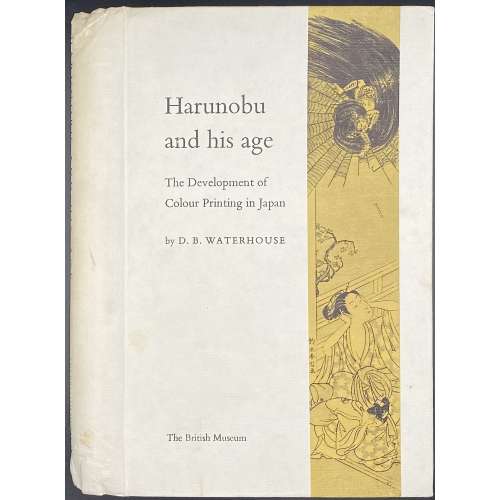
Pictorial cloth boards, spiral-bound, pp.: 3 leaves: h.t., frontis., t.p., 1-326; 123 black & white plates within the pagination.
-
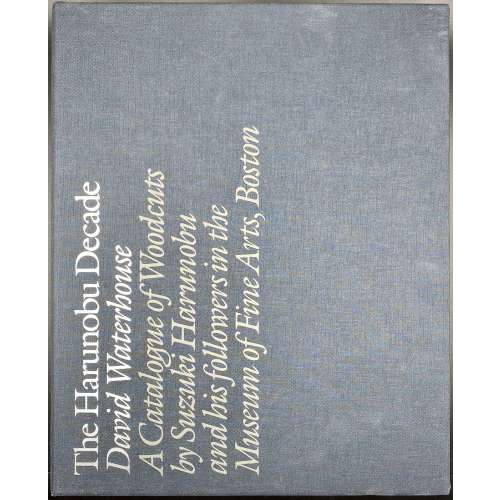 Two volumes in blue cloth, 30.3 x 25.2 cm each, in a matching slipcase 31.5 x 25.5 x 6.5 cm, with silver lettering. Vol. 1: Text, pp.: [1-8] 9-502 [2 blank]; Vol. 2: Plates, 240 unpaginated pages (721 entries). Suzuki Harunobu (Japanese, 1725 – 1770) David B. Waterhouse (British, 1936 – 2017)
Two volumes in blue cloth, 30.3 x 25.2 cm each, in a matching slipcase 31.5 x 25.5 x 6.5 cm, with silver lettering. Vol. 1: Text, pp.: [1-8] 9-502 [2 blank]; Vol. 2: Plates, 240 unpaginated pages (721 entries). Suzuki Harunobu (Japanese, 1725 – 1770) David B. Waterhouse (British, 1936 – 2017) -
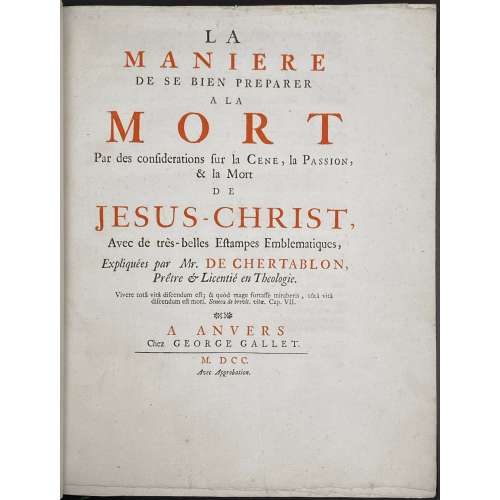 M. de Chertablon. La maniere de se bien preparer a la Mort par des Considerations sur la Cene, la Passion, et la Mort de Jesu-Christ. – Antwerp: George Gallet, 1700. Pagination: ff, [2 - blanks] [2 - t.p., blank] [3 - advert.] 4-63 [64]; 42 copper etched plates by Romeyn de Hooghe: A, B, C, 1-39; [20 - Dutch plate description of the David de la Vigne's Miroir de la bonne mort], bf. Full title: La maniere de se bien preparer a la Mort par des Considerations sur la Cene, la Passion, et la Mort de Jesu-Christ, Avec de très-belles Estampes Emblematiques, Expliquées par Mr. de Chertablon, Piêtre & Licentié en Theologie. Vivere totâ vitâ discendum est; & quòd mage fortasse miraberis, tôtâ vitâ discendum est mori. Seneca de brevit. vitæ. Cap. VII. A Anvers, Chez George Gallet. M DCC, Avec Approbation. / David de La Vigne. Spiegel om wel te sterven, annwyzende met beeltenissen van het lyden onses zaligmaakers Jesu Christi. Verzierd met 42 fyne Geërste Kopere Platen, Door Romain de Hooghe; Te Amsterdam, Voor dezen gedrukt by J. Stigter. Size: 4to, 27.2 x 21.6 cm. Binding: Late 19th century brown calf over marbled boards, spine with gilt lettering, raised bands, double fillet blind panels in compartments; marbled end-papers; bookplate of Samuel Ashton Thompson Yates library, AD 1894. Book illustrated with 42 copperplate etched engravings by Romeyn de Hooghe (Dutch, Amsterdam 1645–1708 Haarlem). According to Bonhams: the plates were "first printed for David de la Vigne's Miroir de la bonne mort. Each of the plates depicts a man contemplating a religious image in order to ease the passing of death, accompanied by commentary and an appropriate verse of scripture for each plate. The present French edition is bound with, as issued, the Dutch translation of David de La Vigne's aforementioned work."
M. de Chertablon. La maniere de se bien preparer a la Mort par des Considerations sur la Cene, la Passion, et la Mort de Jesu-Christ. – Antwerp: George Gallet, 1700. Pagination: ff, [2 - blanks] [2 - t.p., blank] [3 - advert.] 4-63 [64]; 42 copper etched plates by Romeyn de Hooghe: A, B, C, 1-39; [20 - Dutch plate description of the David de la Vigne's Miroir de la bonne mort], bf. Full title: La maniere de se bien preparer a la Mort par des Considerations sur la Cene, la Passion, et la Mort de Jesu-Christ, Avec de très-belles Estampes Emblematiques, Expliquées par Mr. de Chertablon, Piêtre & Licentié en Theologie. Vivere totâ vitâ discendum est; & quòd mage fortasse miraberis, tôtâ vitâ discendum est mori. Seneca de brevit. vitæ. Cap. VII. A Anvers, Chez George Gallet. M DCC, Avec Approbation. / David de La Vigne. Spiegel om wel te sterven, annwyzende met beeltenissen van het lyden onses zaligmaakers Jesu Christi. Verzierd met 42 fyne Geërste Kopere Platen, Door Romain de Hooghe; Te Amsterdam, Voor dezen gedrukt by J. Stigter. Size: 4to, 27.2 x 21.6 cm. Binding: Late 19th century brown calf over marbled boards, spine with gilt lettering, raised bands, double fillet blind panels in compartments; marbled end-papers; bookplate of Samuel Ashton Thompson Yates library, AD 1894. Book illustrated with 42 copperplate etched engravings by Romeyn de Hooghe (Dutch, Amsterdam 1645–1708 Haarlem). According to Bonhams: the plates were "first printed for David de la Vigne's Miroir de la bonne mort. Each of the plates depicts a man contemplating a religious image in order to ease the passing of death, accompanied by commentary and an appropriate verse of scripture for each plate. The present French edition is bound with, as issued, the Dutch translation of David de La Vigne's aforementioned work." -
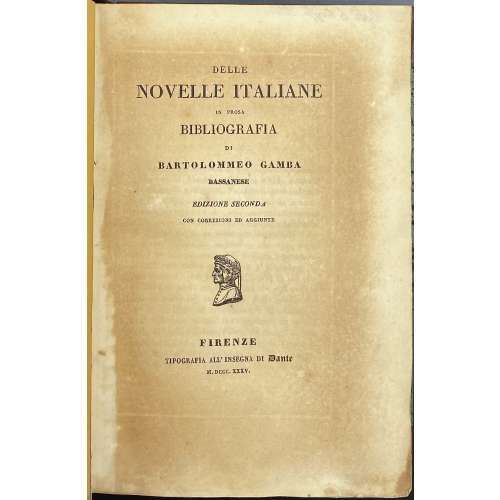 Title-page: DELLE | NOVELLE ITALIANE | IN PROSA | BIBLIOGRAFIA | DI | BARTOLOMMEO GAMBA | BASSANESE | EDIZIONE SECONDA | CON CORREZIONI ED AGGIUNTE | {publisher’s device} | FIRENZE | TIPOGRAFIA ALL’INSEGNA DI Dante | M.DCCC.XXXV. || Collation: 8vo; π8 1-198; an extra leaf between 18 and 19 (189, pp. 289-10, errata), leaf 11 unsigned, leaf 12 signed 11. Total 161 leaves plus 6 leaves of plates extraneous to collation; Plates (copperplate engravings): (1) Giovanni Boccaccio, (2) Angelo Firezuola (i.e. Agnolo Firenzuola), (3) Lorenzo Magalotti, (4) Gasparo Gozzi, and (5) Michele Colombo by Marco Comirato, and (6) Franco Sacchetti by Francesco Bosa. Pagination: [i-iii] iv-xv [xvi] [1-3] 4-290, index [16], total 322 pages plus 6 plates, unpaginated. Binding: 22.4 x 15 cm, modern brown half-morocco over green sprinkled boards, red label with gilt lettering, publisher’s yellow wrappers preserved. Edition: 2nd; the 1st edition was published in 1833. Contributors: Bartolommeo Gamba (Italian, 1766 – 1841) – author, complier. Marco Comirato (Italian, c. 1800 – 1869) – engraver. Francesco Bosa (Italian, ? – ?) – engraver. Sitters: Giovanni Boccaccio (Italian, 1313 –1375) Franco Sacchetti (Italian, c. 1335 – c. 1400) Agnolo Firenzuola] (Italian, 1493 – 1543) Lorenzo Magalotti (Italian, 1637 – 1712) Gasparo Gozzi (Italian, 1713 – 1786) Michele Colombo (Italian, 1747 – 1838)
Title-page: DELLE | NOVELLE ITALIANE | IN PROSA | BIBLIOGRAFIA | DI | BARTOLOMMEO GAMBA | BASSANESE | EDIZIONE SECONDA | CON CORREZIONI ED AGGIUNTE | {publisher’s device} | FIRENZE | TIPOGRAFIA ALL’INSEGNA DI Dante | M.DCCC.XXXV. || Collation: 8vo; π8 1-198; an extra leaf between 18 and 19 (189, pp. 289-10, errata), leaf 11 unsigned, leaf 12 signed 11. Total 161 leaves plus 6 leaves of plates extraneous to collation; Plates (copperplate engravings): (1) Giovanni Boccaccio, (2) Angelo Firezuola (i.e. Agnolo Firenzuola), (3) Lorenzo Magalotti, (4) Gasparo Gozzi, and (5) Michele Colombo by Marco Comirato, and (6) Franco Sacchetti by Francesco Bosa. Pagination: [i-iii] iv-xv [xvi] [1-3] 4-290, index [16], total 322 pages plus 6 plates, unpaginated. Binding: 22.4 x 15 cm, modern brown half-morocco over green sprinkled boards, red label with gilt lettering, publisher’s yellow wrappers preserved. Edition: 2nd; the 1st edition was published in 1833. Contributors: Bartolommeo Gamba (Italian, 1766 – 1841) – author, complier. Marco Comirato (Italian, c. 1800 – 1869) – engraver. Francesco Bosa (Italian, ? – ?) – engraver. Sitters: Giovanni Boccaccio (Italian, 1313 –1375) Franco Sacchetti (Italian, c. 1335 – c. 1400) Agnolo Firenzuola] (Italian, 1493 – 1543) Lorenzo Magalotti (Italian, 1637 – 1712) Gasparo Gozzi (Italian, 1713 – 1786) Michele Colombo (Italian, 1747 – 1838) -
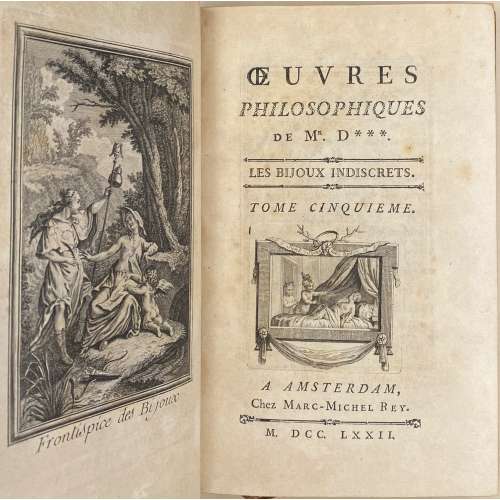 One volume, collated 8vo, 19.5 x 13 cm, later bound in brown full morocco by Pouillet, gilt-bordered covers, raised bands to spine, gilt in compartments, gilt-lettered, double-fillet on cover edges, gilt dentelle inside, signed, all edges gilt, marbled endpapers. Title-page: ŒUVRES | PHILOSOPHIQUES | DE MR. D ***. | — | LES BIJOUX INDISCRETS | — | TOME CINQUIEME | {vignette} | A AMSTERDAM, | Chez Marc-Michel Rey. | — | M. DCC. LXXII. || Pagination: [8] [1] 2-389 [390], total 398 pages, frontis., vignette, plates. Collation: 3 blank leaves at front and rear, π2 a2 A-Aa8 Bb3, total 199 leaves plus 7 unsigned engraved plates incl. frontispiece, and engraved vignette to t.p. Catalogue raisonné: Cohen-DeRicci 303; Lewine 145-6: …with the plates which have been copied and reduced in the undated Cazin edition (1771 and 1785). Contributors: Marc-Michel Rey (Dutch, 1720 – 1780) – publisher. Denis Diderot (French, 1713 – 1784) – author.
One volume, collated 8vo, 19.5 x 13 cm, later bound in brown full morocco by Pouillet, gilt-bordered covers, raised bands to spine, gilt in compartments, gilt-lettered, double-fillet on cover edges, gilt dentelle inside, signed, all edges gilt, marbled endpapers. Title-page: ŒUVRES | PHILOSOPHIQUES | DE MR. D ***. | — | LES BIJOUX INDISCRETS | — | TOME CINQUIEME | {vignette} | A AMSTERDAM, | Chez Marc-Michel Rey. | — | M. DCC. LXXII. || Pagination: [8] [1] 2-389 [390], total 398 pages, frontis., vignette, plates. Collation: 3 blank leaves at front and rear, π2 a2 A-Aa8 Bb3, total 199 leaves plus 7 unsigned engraved plates incl. frontispiece, and engraved vignette to t.p. Catalogue raisonné: Cohen-DeRicci 303; Lewine 145-6: …with the plates which have been copied and reduced in the undated Cazin edition (1771 and 1785). Contributors: Marc-Michel Rey (Dutch, 1720 – 1780) – publisher. Denis Diderot (French, 1713 – 1784) – author. -
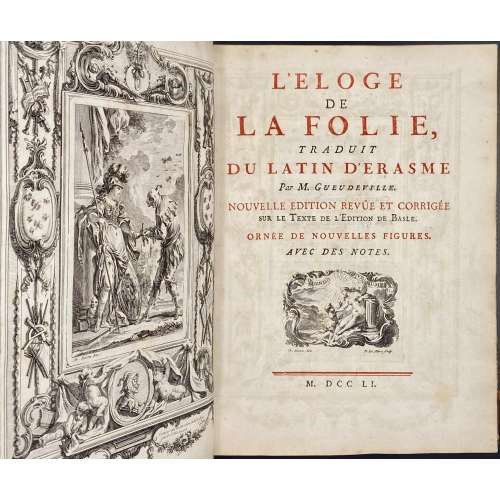 Title: L'ELOGE | DE | LA FOLIE, | TRADUIT | DU LATIN D'ERASME | Par M. Gueudeville. | NOUVELLE EDITION REVÛE & CORRIGÉE | sur le Texte de l'Edition de Basle. | ORNÉE DE NOUVELLES FIGURES. | AVEC DES NOTES. | {vignette Eisen / Le Mire} | — | M. DCC LI. || Pagination: [2 blank] [2] – h.t. / blank, [2] – t.p. / {citation*} | [4] – explication des figures; [i] ii-xxiv, [1] 2-222, [2] – table, [2 blank], plus frontispiece and 13 plates by various engravers after Charles Eisen, total number of pages 10+24+222+4=260, ils. Collation: 4to; [1 blank], π4 a-c4 A-Ee4 [1 blank], total number of leaves 130 plus frontispiece and 13 plates. Plates printed in black, paper 24 x 17.8 cm (grand papeir, 9.5 x 7 inches). Binding: Contemporary mottled calf, triple fillet gilt border with pomegranate corner pieces to boards, spine with raised bands, gilt foliage and pomegranates in compartments, red morocco spine label, all edges gilt, rebacked preserving the original spine and peacock marbled endpapers. Size: 24.8 x 18.8 cm; leaves 24 x 17.8 cm; text printed area: 10 x 6 cm. * Citattion: Admonere voluimus, non lædere: | Consulere moribus Hominum, | non officere. | Erasm. Epist. ad Mart. Dorpium Theolog. Usually, the citation is "Admonere voluimus, non mordere; prodesse, non laedere…", etc. Rococo-framed frontispiece engraved by Martinasie under the supervision of Le Bas. Contributors: Erasmus, Desiderius [Roterodamus] (Dutch, 1466 – 1536) – author. Gueudeville, Nicolas (French, 1652 – 1721) – translator. Meusnier de Querlon, Anne-Gabriel (French, 1702 – 1780) – notes. Eisen, Charles (French, 1720 – 1778) – artist. Engravers: Aliamet, Jacques (French, 1726 – 1788) Flipart, Charles Joseph (French, 1721 – 1797) Beauvais, Nicolas Dauphin de (French, 1687 – 1736) Pinssio [Pincio], Sébastien (French, 1721 – after 1744) Martenasie, Pierre François (French-Flemish, 1729 – 1789) Le Bas [Lebas], Jacques-Philippe (French, 1707 – 1783) Provenance: Bishop, Cortlandt Field (American, 1870 – 1935) – bookplate. Mary S. Collins – bookplate by J. H. Fincken. Robin F. Satinsky (American, 1919 – 2008) – Robin Collection bookplate. Catalogue raisonné: Cohen–deRichi 348-349; Lewine, p. 170; Ray (French) № 24, pp. 52-54.
Title: L'ELOGE | DE | LA FOLIE, | TRADUIT | DU LATIN D'ERASME | Par M. Gueudeville. | NOUVELLE EDITION REVÛE & CORRIGÉE | sur le Texte de l'Edition de Basle. | ORNÉE DE NOUVELLES FIGURES. | AVEC DES NOTES. | {vignette Eisen / Le Mire} | — | M. DCC LI. || Pagination: [2 blank] [2] – h.t. / blank, [2] – t.p. / {citation*} | [4] – explication des figures; [i] ii-xxiv, [1] 2-222, [2] – table, [2 blank], plus frontispiece and 13 plates by various engravers after Charles Eisen, total number of pages 10+24+222+4=260, ils. Collation: 4to; [1 blank], π4 a-c4 A-Ee4 [1 blank], total number of leaves 130 plus frontispiece and 13 plates. Plates printed in black, paper 24 x 17.8 cm (grand papeir, 9.5 x 7 inches). Binding: Contemporary mottled calf, triple fillet gilt border with pomegranate corner pieces to boards, spine with raised bands, gilt foliage and pomegranates in compartments, red morocco spine label, all edges gilt, rebacked preserving the original spine and peacock marbled endpapers. Size: 24.8 x 18.8 cm; leaves 24 x 17.8 cm; text printed area: 10 x 6 cm. * Citattion: Admonere voluimus, non lædere: | Consulere moribus Hominum, | non officere. | Erasm. Epist. ad Mart. Dorpium Theolog. Usually, the citation is "Admonere voluimus, non mordere; prodesse, non laedere…", etc. Rococo-framed frontispiece engraved by Martinasie under the supervision of Le Bas. Contributors: Erasmus, Desiderius [Roterodamus] (Dutch, 1466 – 1536) – author. Gueudeville, Nicolas (French, 1652 – 1721) – translator. Meusnier de Querlon, Anne-Gabriel (French, 1702 – 1780) – notes. Eisen, Charles (French, 1720 – 1778) – artist. Engravers: Aliamet, Jacques (French, 1726 – 1788) Flipart, Charles Joseph (French, 1721 – 1797) Beauvais, Nicolas Dauphin de (French, 1687 – 1736) Pinssio [Pincio], Sébastien (French, 1721 – after 1744) Martenasie, Pierre François (French-Flemish, 1729 – 1789) Le Bas [Lebas], Jacques-Philippe (French, 1707 – 1783) Provenance: Bishop, Cortlandt Field (American, 1870 – 1935) – bookplate. Mary S. Collins – bookplate by J. H. Fincken. Robin F. Satinsky (American, 1919 – 2008) – Robin Collection bookplate. Catalogue raisonné: Cohen–deRichi 348-349; Lewine, p. 170; Ray (French) № 24, pp. 52-54. -
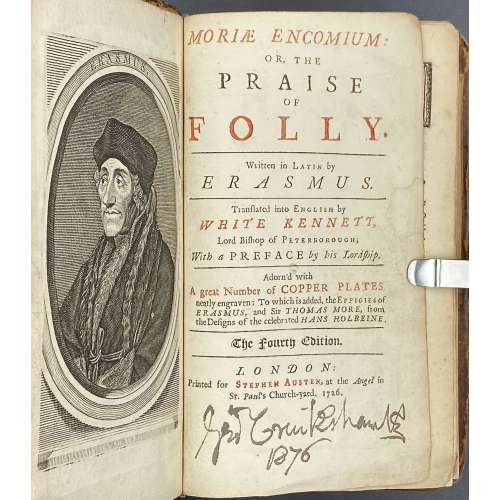 Erasmus. The praise of folly / Translated by White Kennett. — London: Stephen Austen, 1726. Title page in black and red: MORIÆ ENCOMIUM: | OR, THE | PRAISE | OF | FOLLY. |—| Written in Latin by | ERASMUS. |—| Translated into English by | WHITE KENNETT, | Lord Bishop of Peterborough; | With a PREFACE by his Lordship. |—| Adorn’d with | A great Number of COPPER PLATES | neatly engraven: To which is added, the Effigies of | ERASMUS, and Sir THOMAS MORE, from | theDesigns of the celebrated HANS HOLBEINE. |—| (in gothic letters) The Fourth Edition. |—| LONDON: | Printed for Stephen Austen, at the Angel in | St. Pauls’ Church-yard. 1726. || Pagination: modern endpapers and flyleaves, [2] – blank / frontis. (engraved portrait of Erasmus, [2] – t.p. in black and red with George Cruikshank’s signature in the bottom, dated 1876 / blank, [14] – to the reader, i-xiv – commendatory verses, [2] – John Wilford advert., folding portrait of Thomas More, i-v, [vi] - epistle, 1-168 – panegyrick, [4] – index.; 46 copper-engraved illustrations after Hans Holbein the Younger; pp. 17-20 detached. Collation: 12mo; π2 A6, a-b6, B-P6 Q2 (B3 unsigned), 13 in-text engravings + 26 plates + 7 folding plates; total 106 leaves and 33 plates, extraneous to collation. Edition: 4th, thus. Binding: 16.5 x 10.5 cm; rebacked with a modern spine, modern endpapers and flyleaves, contemporary boards sprinkled and tooled in a style of Cambridge panel. Provenance: Cruikshank, George (British, 1792 – 1878) [1876]; Stephen Whitehead (Oakland, CA) [2021]. Catalogue raisonné: J. Lewine (1898) p. 171 — 1st edition thus of 1709, in-8vo, with portrait and 46 plates after Holbein. Contributors: Desiderius Erasmus Roterodamus (Dutch, c. 1469 – 1536) – author of the original text in Latin.
Erasmus. The praise of folly / Translated by White Kennett. — London: Stephen Austen, 1726. Title page in black and red: MORIÆ ENCOMIUM: | OR, THE | PRAISE | OF | FOLLY. |—| Written in Latin by | ERASMUS. |—| Translated into English by | WHITE KENNETT, | Lord Bishop of Peterborough; | With a PREFACE by his Lordship. |—| Adorn’d with | A great Number of COPPER PLATES | neatly engraven: To which is added, the Effigies of | ERASMUS, and Sir THOMAS MORE, from | theDesigns of the celebrated HANS HOLBEINE. |—| (in gothic letters) The Fourth Edition. |—| LONDON: | Printed for Stephen Austen, at the Angel in | St. Pauls’ Church-yard. 1726. || Pagination: modern endpapers and flyleaves, [2] – blank / frontis. (engraved portrait of Erasmus, [2] – t.p. in black and red with George Cruikshank’s signature in the bottom, dated 1876 / blank, [14] – to the reader, i-xiv – commendatory verses, [2] – John Wilford advert., folding portrait of Thomas More, i-v, [vi] - epistle, 1-168 – panegyrick, [4] – index.; 46 copper-engraved illustrations after Hans Holbein the Younger; pp. 17-20 detached. Collation: 12mo; π2 A6, a-b6, B-P6 Q2 (B3 unsigned), 13 in-text engravings + 26 plates + 7 folding plates; total 106 leaves and 33 plates, extraneous to collation. Edition: 4th, thus. Binding: 16.5 x 10.5 cm; rebacked with a modern spine, modern endpapers and flyleaves, contemporary boards sprinkled and tooled in a style of Cambridge panel. Provenance: Cruikshank, George (British, 1792 – 1878) [1876]; Stephen Whitehead (Oakland, CA) [2021]. Catalogue raisonné: J. Lewine (1898) p. 171 — 1st edition thus of 1709, in-8vo, with portrait and 46 plates after Holbein. Contributors: Desiderius Erasmus Roterodamus (Dutch, c. 1469 – 1536) – author of the original text in Latin.White Kennett (British, 1660 – 1728) – translator from Latin into English.
Hans Holbein the Younger (German, 1497/8 – 1543) – artist.
Stephen Austen (fl. c. 1727 – 1746) – publisher. Linked items: Engraved portrait of Erasmus of Rotterdam in an octagonal frame, 1757 by Flipart after Holbein.Эразм Роттердамский. Похвальное слово глупости. — М.-Л.: Academia, 1932.
-
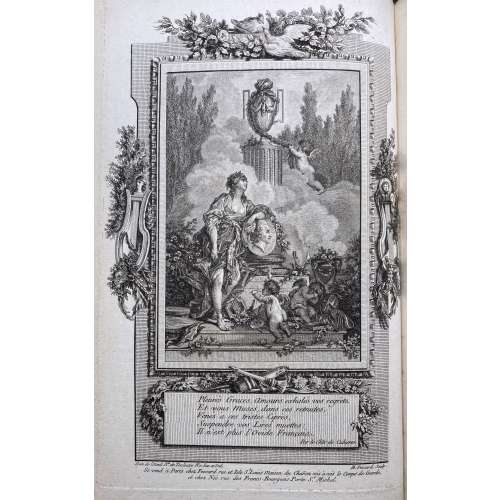 Title page: LES | BAISERS , | PRÉCÉDES | DU MOIS DE MAI, | POËME. | [vignette] | A LA HAYE , | Et se trouve à Paris | Chez Lambert , Imprimeur, rue de la Harpe. | Et Delalain , rue de la Comédie Françoise. | M. DCC. LXX Size: 8vo; 24.5 x 15.5 cm; Binding by Hippolyte Duru – stamp at the back of the front end paper DURU, 1855; full red calf, boards decorated in gilt, raised bands and gilt decorations in compartments, gilt lettering, AEG, peacock marbled end papers, text and illustrations printed on Holland paper. Collation: 2 ffls, engraved half-title by N. Ponce after Ch. Eisen, frontispiece by Etienne Fessard after Claude-Jean-Baptiste Hoin (French, 1750 – 1817) w/guard tissue, t.p. by J. Aliamet after Ch. Eisen, Réflexions préliminaires: A8, B4; 'Le Mois de Mai' half-title, imprim. note on verso, frontispice by De Longueil after Ch. Eisen w/guard tissue, A4 C-F(8) H4; 2bfls. Frontispiece by Etienne Fessard is unique in this edition. Pagination: [2] 3-24, [27]/28, 5/6, 31/32 31/34 11/12 37-119 [120], 22 head-pieces after Ch. Eisen and 22 end-pieces after Marillier, engraved by Baquoy, Binet, Delaunay, Lingée, De Longueil, Masquelier, Massard, and Née. Mistakes in pagination likely confirms first printing first edition. Catalogue raisonné: Cohen, De Ricci (1912): 308-311). Artists: Charles Eisen (French, 1720–1778); Clément Pierre Marillier (French, 1740–1808), and Claude-Jean-Baptiste Hoin (French, 1750–1817). Engravers: Jacques Aliamet (French, 1726–1788); Jean Charles Baquoy (French, 1721–1777); Louis Binet (French, 1744–about 1800); Nicolas Delaunay (French, 1739–1792); Etienne Fessard (French, 1714–1777); Charles Louis Lingée (French, 1748–1819); Joseph de Longueil (French, 1730–1792); Louis Joseph Masquelier (French, 1741–1811); Jean Massard (1740–1822); François Denis Née (French, 1735–1818); Nicholas Ponce (French, 1746–1831).
Title page: LES | BAISERS , | PRÉCÉDES | DU MOIS DE MAI, | POËME. | [vignette] | A LA HAYE , | Et se trouve à Paris | Chez Lambert , Imprimeur, rue de la Harpe. | Et Delalain , rue de la Comédie Françoise. | M. DCC. LXX Size: 8vo; 24.5 x 15.5 cm; Binding by Hippolyte Duru – stamp at the back of the front end paper DURU, 1855; full red calf, boards decorated in gilt, raised bands and gilt decorations in compartments, gilt lettering, AEG, peacock marbled end papers, text and illustrations printed on Holland paper. Collation: 2 ffls, engraved half-title by N. Ponce after Ch. Eisen, frontispiece by Etienne Fessard after Claude-Jean-Baptiste Hoin (French, 1750 – 1817) w/guard tissue, t.p. by J. Aliamet after Ch. Eisen, Réflexions préliminaires: A8, B4; 'Le Mois de Mai' half-title, imprim. note on verso, frontispice by De Longueil after Ch. Eisen w/guard tissue, A4 C-F(8) H4; 2bfls. Frontispiece by Etienne Fessard is unique in this edition. Pagination: [2] 3-24, [27]/28, 5/6, 31/32 31/34 11/12 37-119 [120], 22 head-pieces after Ch. Eisen and 22 end-pieces after Marillier, engraved by Baquoy, Binet, Delaunay, Lingée, De Longueil, Masquelier, Massard, and Née. Mistakes in pagination likely confirms first printing first edition. Catalogue raisonné: Cohen, De Ricci (1912): 308-311). Artists: Charles Eisen (French, 1720–1778); Clément Pierre Marillier (French, 1740–1808), and Claude-Jean-Baptiste Hoin (French, 1750–1817). Engravers: Jacques Aliamet (French, 1726–1788); Jean Charles Baquoy (French, 1721–1777); Louis Binet (French, 1744–about 1800); Nicolas Delaunay (French, 1739–1792); Etienne Fessard (French, 1714–1777); Charles Louis Lingée (French, 1748–1819); Joseph de Longueil (French, 1730–1792); Louis Joseph Masquelier (French, 1741–1811); Jean Massard (1740–1822); François Denis Née (French, 1735–1818); Nicholas Ponce (French, 1746–1831). -
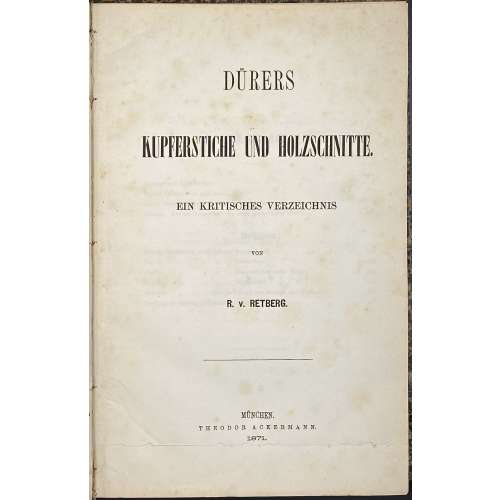 Publisher’s blue wrapper: DÜRERS | KUPFERSTICHE UND HOLZSCHNITTE. | EIN KRITISCHES VERZEICHNIS | VON | R. v. RETBERG. | MÜNCHEN. | THEODOR ACKERMANN. | 1871. || Title page: similar to front wrapper, 2.5 cm cut at the bottom, text not affected. Pagination: front wrapper with lettering in a frame, flyleaf, [4] 1-169 [170 blank] [2], flyleaf, back wrapper with imprint plus 2 plates (frontis., Il. entry №129, and op. p., il. entry 100 № 260, printed on laid paper without watermark). Collation: π2 1-88 9-134 142, plus 2 plates extraneous to collation, incl. frontispiece. Binding: 26.4 x 17.5 cm, quarter green morocco over marbled boards, black compartment fillets and lettering to spine, publisher’s wrappers preserved. Marks: bookplate 6 x 9 cm to front pastedown: “БИБЛИОТЕКА | ГОСУДАРСТВЕННОГО | ЭРМИТАЖА ИЗ СОБРАНИЯ | СТЕПАНА ПЕТРОВИЧА | ЯРЕМИЧА | (1869 – 1939)”, purple ink stamp “В ПРОДАЖУ”. To front wrapper: Ink manuscript on top “Dr. Lichtenstein”… etc., black ink seal of rampant lion and pencil number “949” in the middle; pencil marks to p. 162.
Publisher’s blue wrapper: DÜRERS | KUPFERSTICHE UND HOLZSCHNITTE. | EIN KRITISCHES VERZEICHNIS | VON | R. v. RETBERG. | MÜNCHEN. | THEODOR ACKERMANN. | 1871. || Title page: similar to front wrapper, 2.5 cm cut at the bottom, text not affected. Pagination: front wrapper with lettering in a frame, flyleaf, [4] 1-169 [170 blank] [2], flyleaf, back wrapper with imprint plus 2 plates (frontis., Il. entry №129, and op. p., il. entry 100 № 260, printed on laid paper without watermark). Collation: π2 1-88 9-134 142, plus 2 plates extraneous to collation, incl. frontispiece. Binding: 26.4 x 17.5 cm, quarter green morocco over marbled boards, black compartment fillets and lettering to spine, publisher’s wrappers preserved. Marks: bookplate 6 x 9 cm to front pastedown: “БИБЛИОТЕКА | ГОСУДАРСТВЕННОГО | ЭРМИТАЖА ИЗ СОБРАНИЯ | СТЕПАНА ПЕТРОВИЧА | ЯРЕМИЧА | (1869 – 1939)”, purple ink stamp “В ПРОДАЖУ”. To front wrapper: Ink manuscript on top “Dr. Lichtenstein”… etc., black ink seal of rampant lion and pencil number “949” in the middle; pencil marks to p. 162.Contents: Inhalt - Berichtigungen - Vorwort und Einleitendes - Dürers Lebenskizze - [Text] - Nachtrag zu Dürers "Lebenskizze". A critical directory of Albrecht Dürer (German, 1471 – 1528) copperplate engravings and woodcuts by Ralf von Retberg (German, 1812 – 1885): the description of 167 woodcuts and 103 copperplate engravings.
Provenance: From the collection of a Russian artist Stepan Petrovich Yaremich, sold by Hermitage Museum in St. Petersburg. Ref: Royal Academy. -
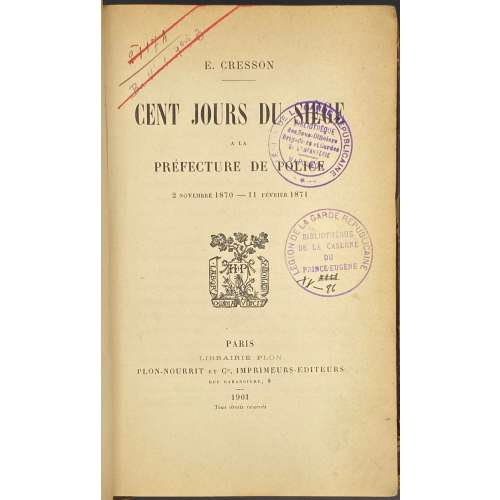 Title-page: E. CRESSON |—| CENT JOURS DE SIÈGE | A LA | PRÉFECTURE DE POLICE | 2 NOVEMBRE 1870 — 11 FÉVRIER 1871 | {publisher’s device} | PARIS | LIBRAIRIE PLON | PLON-NOURRIT ET Cie, IMPRIMEURS-ÉDITEURS | RUE GARANCIÈRE, 8 | 1901 | Tous droits réservés || Description: 8vo, 22 x 14.5 cm, quarter brown calf over marbled boards, flat spine with gilt fillets, gilt lettering, marbled endpapers; inscriptions to t.p.: 2117 A | Ba V –1 1bis 3; ink stamps to t.p.: (1) « LÉGION DE LA GARDE REPUBLICAINE | BIBLIOTÈQUE | des Sous-Officiers | Brigadiers et Gardes | DE L’INFANTERIA | NAPOLEON » ; (2) « LÉGION DE LA GARDE REPUBLICAINE | BIBLIOTÈQUE | DE LA CASERNE | DU | PRINCE-EUGÈNE | (hand) XIII | XX—86 » Collation: 8vo; π6 1-248 252, total 200 leaves. Pagination: [2] [i-v] vi-x, [1] 2-385 [3], total 400 pages. BNF: ark:/12148/bpt6k4936n Author: Ernest Cresson (French, 1824 – 1902)
Title-page: E. CRESSON |—| CENT JOURS DE SIÈGE | A LA | PRÉFECTURE DE POLICE | 2 NOVEMBRE 1870 — 11 FÉVRIER 1871 | {publisher’s device} | PARIS | LIBRAIRIE PLON | PLON-NOURRIT ET Cie, IMPRIMEURS-ÉDITEURS | RUE GARANCIÈRE, 8 | 1901 | Tous droits réservés || Description: 8vo, 22 x 14.5 cm, quarter brown calf over marbled boards, flat spine with gilt fillets, gilt lettering, marbled endpapers; inscriptions to t.p.: 2117 A | Ba V –1 1bis 3; ink stamps to t.p.: (1) « LÉGION DE LA GARDE REPUBLICAINE | BIBLIOTÈQUE | des Sous-Officiers | Brigadiers et Gardes | DE L’INFANTERIA | NAPOLEON » ; (2) « LÉGION DE LA GARDE REPUBLICAINE | BIBLIOTÈQUE | DE LA CASERNE | DU | PRINCE-EUGÈNE | (hand) XIII | XX—86 » Collation: 8vo; π6 1-248 252, total 200 leaves. Pagination: [2] [i-v] vi-x, [1] 2-385 [3], total 400 pages. BNF: ark:/12148/bpt6k4936n Author: Ernest Cresson (French, 1824 – 1902) -
![E. de Crauzat. L'Œuvre gravé et lithographié de Steinlen: Catalogue descriptif et analytique suivi d'un essai de bibliographie et d'Iconographie de son œuvre illustré / Préface de Roger Marx. — San Francisco: Alan Wofsy Fine Arts, 1983. — Fac similé de l'édition originale de 1913. — pp.: [i-ix] x-xv [1-3] 4-228 [229-234]. — [Ernest de Crauzat].](https://varshavskycollection.com/wp-content/uploads/2021/02/LIB-2289.2019-d-500x500.jpeg) Title: DE CRAUZAT | L'ŒUVRE | Gravé et Lithographié | DE | STEINLEN | Catalogue descriptif et analytique | suivi d'un essai de bibliographie et d'Iconographie | de son œuvre illustré. | PRÉFACE | DE ROGER MARX | San Francisco | Alan Wofsy Fine Arts | 1983. Edition: Fac-similé de l'édition originale de 1913. Pagination: [i-ix] x-xv [1-3] 4-228 [229-234]. Size: 32 x 24 cm.
Title: DE CRAUZAT | L'ŒUVRE | Gravé et Lithographié | DE | STEINLEN | Catalogue descriptif et analytique | suivi d'un essai de bibliographie et d'Iconographie | de son œuvre illustré. | PRÉFACE | DE ROGER MARX | San Francisco | Alan Wofsy Fine Arts | 1983. Edition: Fac-similé de l'édition originale de 1913. Pagination: [i-ix] x-xv [1-3] 4-228 [229-234]. Size: 32 x 24 cm. -
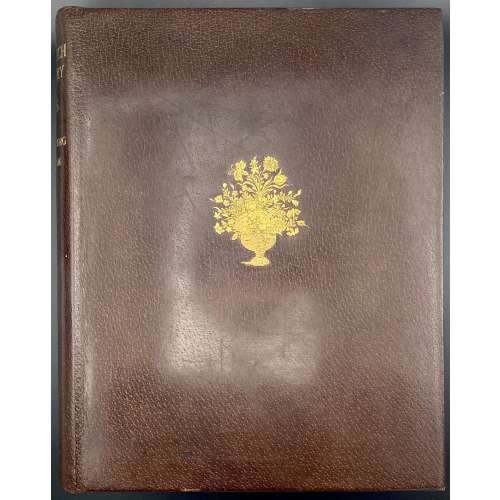 Title: OLD DUTCH | POTTERY AND TILES | BY ELISABETH | NEURDENBURG | LITT. D., READER IN THE HISTORY OF ART AT | THE UNIVERSITY OF GRONINGEN. TRANSLATED | WITH ANNOTATIONS BY | Bernard Rackham | DEPUTY KEEPER, DEPARTMENT | OF CERAMICS, VICTORIA AND | ALBERT MUSEUM | […] | WITH ONE HUNDRED AND TWELVE | ILLUSTRATIONS OF WHICH NINE | ARE IN COLOUR | LONDON: BENN BROTHERS, LIMITED | 8 BOUVERIE STREET, E.C. 4 | 1923 || Verso to half-title: Of this book 100 copies only for sale have been printed on English | hand-made paper, bound in pigskin and signed by the Authoress | and Translator. These copies also contain an extra colour plate. | This in Number “7” (in manuscript) | Two signatures (ink, manuscript) || Pagination: [i, ii] – h.t. / tirage, [iii, iv] – t.p. / imprint, [v, vi] – dedication to Dr. A. Pit / blank, vii-xv [xvi blank] [1, 2] 3-155 [156 blank], frontispiece (colour) and 59 leaves of plates (9 colour) with 112 figures, with lettered protective sheets. Collation: 4to in 8th; [A]8 [B]8 C-K8 L6; frontis., +59 leaves of plates. Binding: 30 x 24 cm, Full dark brown pigskin with gilt ornament to front board and gilt lettering to spine; printed on thick wove paper, top edge gilt, others untrimmed. Contributors: Neurdenburg, Elisabeth (Dutch, 1882 – 1957) – author [autograph]. Rackham, Bernard (British, 1876 – 1964) – translator [autograph]. Brendon, William (British, 1845 – 1928) – printer. Mayflower Press (Plymouth), William Brendon & Son, Ltd. – printer Benn Brothers Ltd. (British company, 1880 – 1987) Benn, Sir John, 1st Baronet (British, 1850 – 1922)
Title: OLD DUTCH | POTTERY AND TILES | BY ELISABETH | NEURDENBURG | LITT. D., READER IN THE HISTORY OF ART AT | THE UNIVERSITY OF GRONINGEN. TRANSLATED | WITH ANNOTATIONS BY | Bernard Rackham | DEPUTY KEEPER, DEPARTMENT | OF CERAMICS, VICTORIA AND | ALBERT MUSEUM | […] | WITH ONE HUNDRED AND TWELVE | ILLUSTRATIONS OF WHICH NINE | ARE IN COLOUR | LONDON: BENN BROTHERS, LIMITED | 8 BOUVERIE STREET, E.C. 4 | 1923 || Verso to half-title: Of this book 100 copies only for sale have been printed on English | hand-made paper, bound in pigskin and signed by the Authoress | and Translator. These copies also contain an extra colour plate. | This in Number “7” (in manuscript) | Two signatures (ink, manuscript) || Pagination: [i, ii] – h.t. / tirage, [iii, iv] – t.p. / imprint, [v, vi] – dedication to Dr. A. Pit / blank, vii-xv [xvi blank] [1, 2] 3-155 [156 blank], frontispiece (colour) and 59 leaves of plates (9 colour) with 112 figures, with lettered protective sheets. Collation: 4to in 8th; [A]8 [B]8 C-K8 L6; frontis., +59 leaves of plates. Binding: 30 x 24 cm, Full dark brown pigskin with gilt ornament to front board and gilt lettering to spine; printed on thick wove paper, top edge gilt, others untrimmed. Contributors: Neurdenburg, Elisabeth (Dutch, 1882 – 1957) – author [autograph]. Rackham, Bernard (British, 1876 – 1964) – translator [autograph]. Brendon, William (British, 1845 – 1928) – printer. Mayflower Press (Plymouth), William Brendon & Son, Ltd. – printer Benn Brothers Ltd. (British company, 1880 – 1987) Benn, Sir John, 1st Baronet (British, 1850 – 1922) -
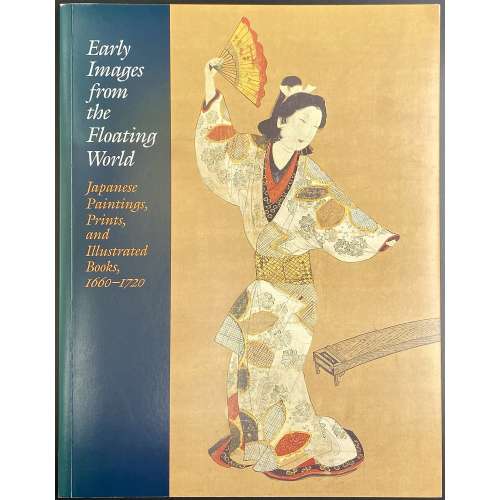 Softcover, in pictorial wrappers, 28 x 21.8 cm, 37 entries, with colour illustrations. Catalogue of the sales exhibition on March 3 - April 5, 2008 in NY; pagination: [1-3] 4-102 [2], ils. Contributor: Sebastian Izzard
Softcover, in pictorial wrappers, 28 x 21.8 cm, 37 entries, with colour illustrations. Catalogue of the sales exhibition on March 3 - April 5, 2008 in NY; pagination: [1-3] 4-102 [2], ils. Contributor: Sebastian Izzard -
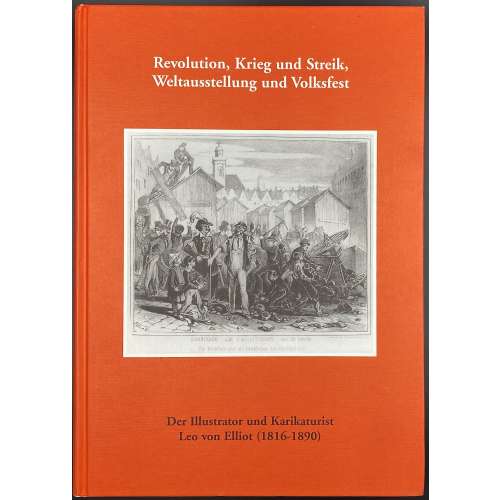 Title: Revolution, Krieg und Streik, | Weltausstellung und Volksfest | Der Illustrator und Karikaturist | Leo von Elliot (1816–1890) | von Eckhart G. Franz | Hessische Historische Kommission Darmstadt 2000 || Series: Arbeiten der Hessischen Historischen Kommission, Neue Folge Band 17. Pagination: [1-6] 7-340, 458 b/w illustration. Binding: hardcover, red pictorial boards, 30 x 21.5 cm.
Title: Revolution, Krieg und Streik, | Weltausstellung und Volksfest | Der Illustrator und Karikaturist | Leo von Elliot (1816–1890) | von Eckhart G. Franz | Hessische Historische Kommission Darmstadt 2000 || Series: Arbeiten der Hessischen Historischen Kommission, Neue Folge Band 17. Pagination: [1-6] 7-340, 458 b/w illustration. Binding: hardcover, red pictorial boards, 30 x 21.5 cm. -
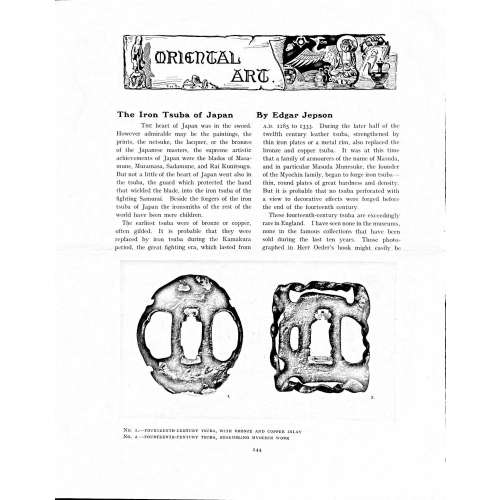 Magazine article by Edgar Jepson: The Iron Tsuba of Japan (Section: Oriental Art), published in volume Vol. 70 (September–December) of The Connoisseur: An Illustrated Magazine for Collectors, Vol. 70 (September–December); pp. 143-152 / C. Reginald Grundy [ed.] — London: Published by the Proprietor, W. CLAUSE JOHNSON, at the Editorial and Advertisement Offices of The Connoisseur, 1924. Owner's half black morocco, gilt lettering to spine, blue cloth boards. Two volumes bound together without original covers. Size 28.5 x 22 cm. Vol. 1: The Connoisseur | An Illustrated Magazine | For Collectors | Edited by C. Reginald Grundy | Vol. LXIX. | (MAY—AUGUST, 1924) | LONDON | Published by the Proprietor, W. CLAUSE JOHNSON, at the | Editorial and Advertisement Offices of The Connoisseur, | at 1, Duke Street, St. James's, S.W. 1 | 1924 || Pp.: [i-ii] iii-xviii [xix] [1, 2 - plate] 3-249 [250]. Vol. 2: The Connoisseur | An Illustrated Magazine | For Collectors | Edited by C. Reginald Grundy | Vol. LXX. | (SEPTEMBER—DECEMBER, 1924) | LONDON | Published by the Proprietor, W. CLAUSE JOHNSON, at the | Editorial and Advertisement Offices of The Connoisseur, | at 1, Duke Street, St. James's, S.W. 1 | 1924 || Pp.: [i-ii] iii-xxii [2 blanks] [1, 2 - plate] 3-261 [262]. The Iron Tsuba of Japan by Edgar Jepson The heart of Japan was in the sword. However admirable may be the paintings, the prints, the netsuke, the lacquer, or the bronzes of the Japanese masters, the supreme artistic achievements of Japan were the blades of Masamune, Muramasa, Sadamune, and Rai Kunitsugu. But not a little of the heart of Japan went also in the tsuba, the guard which protected the hand that wielded the blade, into the iron tsuba of the fighting Samurai. Beside the forgers of the iron tsuba of Japan the ironsmiths of the rest of the world have been mere children. The earliest tsuba were of bronze or copper, often gilded. It is probable that they were replaced by iron tsuba during the Kamakura period, the great fighting era, which lasted from A.D. 1185 to 1333. During the later half of the twelfth century leather tsuba, strengthened by thin iron plates or a metal rim, also replaced the bronze and copper tsuba. It was at this time that a family of armourers of the name of Masuda, and in particular Masuda Munesuke, the founder of the Myochin family, began to forge iron tsuba — thin, round plates of great hardness and density. But it is probable that no tsuba perforated with a view to decorative effects were forged before the end of the fourteenth century. These fourteenth-century tsuba are exceedingly rare in England. I have seen none in the museums, none in the famous collections that have been sold during the last ten years. Those photographed in Herr Oeder's book might easily be the fifteenth century. No. 1 is a curious cup-shape tsuba decorated with a bronze and copper inlay. No. 2, with its edges curiously twisted in the forging, looks like Myochin work. But it is not of the Myochin iron. The Myochin family produced some of the greatest ironsmiths of Japan. Armourers first of all, tsubasmiths, forgers of sake-kettles, articulated reptiles, crustacea, and insects — everything that can be done with iron they did; they pushed their medium to its limit. They were forging iron tsuba in 1160, and they were still forging them in 1860. And it was their own iron, or rather their own steel. They discovered the secret of it early, and they kept that secret in the family for all those hundreds of years. There is no mistaking a Myochin tsuba: balance it on your finger and tap it with a piece of metal, always it gives forth a clear bell-like ring that you get from the work of no other ironsmith, Japanese or European. Always the Myochin tsuba is before everything a protection to the hand of the swordsman; to that everything is, as it should be, subordinated. No. 3 is a Myochin tsuba of the fifteenth century, and probably of the early fifteenth century. No. 4, by Myochin Munetaka, perforated with a grotesque figure, is an example of that twisting and twisting of the iron in the forging till it forms a pattern like the grain of wood. The Myochin smiths invented these wood-grain tsuba, and no other smiths equalled them in their forging. In the sixteenth century, the fighting tsuba was probably at its best. It was a century of great tsubasmiths. Then the first Nobuiye, whose tsuba fetched £100 apiece, circa 1800, in Japan, and the first Kaneiye flourished. No. 5 is a tsuba forged by a great smith, Iyesada of Sotome, in the manner of Nobuiye I, decorated with the karakusa tendrils that Nobuiye delighted in, with lightning and clouds. No. 6 is a guard of Sanada Tembo, the chief smith of the Tembo family, stamped, punning fashion, with the character Tembo. Akin to the Tembo tsuba were those of the Kiami and Hoan smiths. Then also the Heianjo smiths and the Owari smiths, especially those of Nagoya and the Yamakichi family, forged their strongest tsuba. Those of the Yamakichi were tested after the forging by being pounded in iron mortars — at least, so the legend runs. But they were a sternly utilitarian family, and I have never seen a Yamakichi tsuba of any beauty. In the later half of the fifteenth century arose the fashion of decorating tsuba with an inlay, zogan, of bronze. The Heianjo tsuba, forged at Kyoto in the latter half of the fifteenth and the beginning of the sixteenth century, were often thus inlaid. The earliest of them were called "Onin", of which No. 7 is an example. In addition to the bronze inlay around the edge, it is inlaid with a representation, some say, of snow; others say, of the duckweed on a pond. No. 8 is probably a Heianjo tsuba, but I am not quite sure about it. The inlaid acacia branches might be very early Shoami work. But to judge by the iron, it is a fifteenth-century tsuba; and the authorities place the beginning of the Shoami school not later than early in the sixteenth century. No. 10 is an example of the Fushimi-zogan, a flat inlay of a light-coloured bronze. These tsuba took their name from the fact that they were first forged at Fushimi, in Yamashiro, in the sixteenth century. It is of the type known as Mon-zukashi, perforated with crests (mon) à jour. The Yoshiro-zogan tsuba were also first forged at Fushimi by Yoshiro Naomasa. They were distinguished from the Fushimi-zogan by the fact that their inlay was generally a little raised-not always-for the inlay of No. 9, a tsuba forged by a later nineteenth-century Yoshiro, is quite flat. It is an interesting tsuba, for, with its decoration grown florid and excessive, it marks the intermediate stage between the simple and delightful designs of the genuine fighting tsuba and the elaborate pictures in gold and silver on the tsuba of the eighteenth-century smiths of Awa and Kyoto, which have become mere ornaments of the goldsmith. The Gomoku-zogan (No. 11) tsuba were probably first forged earlier than the Fushimi and Yoshiro-zogan tsuba. This inlay, in slight relief, is a representation in a light-coloured bronze and copper of twigs caught in the eddies of streams. The seventeenth century and early eighteenth century were the great periods of perforated tsuba. The designs, and they are often admirable, are for the most part in plain fretwork; but they are also chased. No. 12, a crane under an acacia, is a tsuba of a Higo smith, great forgers of fighting tsuba during this period. These smiths also excelled in nunome zogan, a very thin gold and silver inlay, with which they further decorated their perforated guards. The smiths of the Umetada and Shoami families also forged iron tsuba during this period; but their designs, though sometimes pleasing enough, are rarely fine. The best work of Myoju Umetada is in sentoku, not iron. The Choshu smiths, coming later, surpass the perforated guards of both the Umetada and Shoami smiths in beauty of design. No. 13, a lotus in the round, not only fretwork, but also engraved, is a good example of the admirable balance they so often attained in their designs. It is a sufficiently realistic lotus, but yet of a delightful simplicity. In considerable contrast is No. 14, the dragon by Soheishi Soten — one of the only two authentic tsuba of his forging known — the first forger of hikone-bori tsuba, which were in extraordinary favour in Japan during the eighteenth century, and illustrated every important event in Japanese history. It is on the elaborate side, but fine, strong work, and an excellent guard to the hand, for the lighter and more open part, which gives the design its admirable balance, is on the inside, and not exposed to the full swing of an opponent's blade. A few years ago there was a tendency to decry the Namban tsuba as having sprung too directly from foreign sources. But though the original suggestion may have been Chinese, or, as some say, Portuguese, the Japanese made it entirely their own, as characteristically Japanese as anything can well be, but, it must be admitted, of a decadent period. The school took its rise at the beginning of the seventeenth century, and the early tsuba were forged of a specially hard iron, the Wootz, imported from Southern India. No. 15, the signs of the Zodiac, is an excellent tsuba from the fighting point of view. Both it and No. 16 are of quite charming, if elaborate, design, and both of them, with their delicate scroll-work, so astonishingly undercut, are the very last word in the work of the ironsmith-veritable iron lace. To return to the simpler perforated tsuba, the smiths of Akasaka, a suburb of Tokyo, produced probably the most charming designs. Their style derives considerably from the Higo smiths, and their earlier fighting tsuba are very like the Higo tsuba. But always their work was just a little lighter than that of the Higo smiths, and in the end they moved right away from them and became the forgers of very light guards indeed. No. 17, is a representation of the Hiyokudori, the fabulous double bird, in which were reincarnated the souls of the two lovers, Gompachi and Komurasaki; and No. 18, “the tsuba of a hundred ducks "— there are about forty — are characteristic designs of the school. In the work of the Akasaka smiths the balance, which makes the design of a good tsuba so admirable and delightful, attains its height. This admirable balance seems often to be obtained by a deliberate sacrifice of symmetry. About nine hundred and ninety-nine European ironsmiths out of a thousand would have made the right and left sides of the Hiyoku-dori line by line, and perforation by perforation, exactly alike; he would have cut out exactly as many ducks on the one side of “the tsuba of a hundred ducks” as on the other, and made each duck on the right side correspond exactly in position and attitude with a duck on the left side. By variations the tsubasmith attained a finer balance, almost a higher symmetry. No. 19, often called by collectors the "rose-window" tsuba, but really a stylised chrysanthemum, is a favourite design of the Akasaka smiths, but Hizen work and inlaid in the Hizen manner with gold nunome. No. 20 is a Satsuma tsuba of the middle period. The Satsuma smiths of the nineteenth century produced probably the most ornate of all the iron guards, for the most part calibashes and beans with their leaves and tendrils realistic in the extreme, but of charming design. Few crafts have been carried further than that of the tsubasmith; few crafts working in a difficult medium have handled more subjects with greater feeling for beauty or greater liveliness of fancy. It is interesting to note again and again how school influences school, and smith influences smith. But, as in all the applied arts, the finest tsuba were forged by men who never lost sight of the purpose of a tsuba, that it is before everything a protection to the hand, and never subjected that purpose to a passion for virtuosity. Illustrations: No 1. FOURTEENTH-CENTURY TSUBA, WITH BRONZE AND COPPER INLAY No. 2. FOURTEENTH-CENTURY TSUBA, RESEMBLING MYOCHIN WORK No. 3. MYOCHIN TSUBA, FIFTEENTH CENTURY No. 4. MYOCHIN TSUBA, NINETEENTH CENTURY No. 5. SIXTEENTH-CENTURY TSUBA No. 6. SIXTEENTH-CENTURY TSUBA BY IYESADA OF SOTOME BY SANADA TEMBO No. 7. ONIN TSUBA No. 8. HEIANJO (?) TSUBA No. 9. YOSHIRO TSUBA, NINETEENTH CENTURY No. 10. FUSHIMI-ZOGAN, NINETEENTH CENTURY No. 11.- GOMOKU-ZOGAN, SIXTEENTH CENTURY No. 12. HIGO TSUBA, SEVENTEENTH CENTURY No. 13. CHOSHU TSUBA, SEVENTEENTH CENTURY No. 14. SOTEN TSUBA, SEVENTEENTH CENTURY No. 15. NAMBAN TSUBA, EIGHTEENTH CENTURY No. 16. NAMBAN TSUBA, NINETEENTH CENTURY Nos. 17. AND 18. AKASAKA TSUBA, EIGHTEENTH CENTURY No. 19. HIZEN TSUBA, EIGHTEENTH CENTURY No. 20. SATSUMA TSUBA, EIGHTEENTH CENTURY
Magazine article by Edgar Jepson: The Iron Tsuba of Japan (Section: Oriental Art), published in volume Vol. 70 (September–December) of The Connoisseur: An Illustrated Magazine for Collectors, Vol. 70 (September–December); pp. 143-152 / C. Reginald Grundy [ed.] — London: Published by the Proprietor, W. CLAUSE JOHNSON, at the Editorial and Advertisement Offices of The Connoisseur, 1924. Owner's half black morocco, gilt lettering to spine, blue cloth boards. Two volumes bound together without original covers. Size 28.5 x 22 cm. Vol. 1: The Connoisseur | An Illustrated Magazine | For Collectors | Edited by C. Reginald Grundy | Vol. LXIX. | (MAY—AUGUST, 1924) | LONDON | Published by the Proprietor, W. CLAUSE JOHNSON, at the | Editorial and Advertisement Offices of The Connoisseur, | at 1, Duke Street, St. James's, S.W. 1 | 1924 || Pp.: [i-ii] iii-xviii [xix] [1, 2 - plate] 3-249 [250]. Vol. 2: The Connoisseur | An Illustrated Magazine | For Collectors | Edited by C. Reginald Grundy | Vol. LXX. | (SEPTEMBER—DECEMBER, 1924) | LONDON | Published by the Proprietor, W. CLAUSE JOHNSON, at the | Editorial and Advertisement Offices of The Connoisseur, | at 1, Duke Street, St. James's, S.W. 1 | 1924 || Pp.: [i-ii] iii-xxii [2 blanks] [1, 2 - plate] 3-261 [262]. The Iron Tsuba of Japan by Edgar Jepson The heart of Japan was in the sword. However admirable may be the paintings, the prints, the netsuke, the lacquer, or the bronzes of the Japanese masters, the supreme artistic achievements of Japan were the blades of Masamune, Muramasa, Sadamune, and Rai Kunitsugu. But not a little of the heart of Japan went also in the tsuba, the guard which protected the hand that wielded the blade, into the iron tsuba of the fighting Samurai. Beside the forgers of the iron tsuba of Japan the ironsmiths of the rest of the world have been mere children. The earliest tsuba were of bronze or copper, often gilded. It is probable that they were replaced by iron tsuba during the Kamakura period, the great fighting era, which lasted from A.D. 1185 to 1333. During the later half of the twelfth century leather tsuba, strengthened by thin iron plates or a metal rim, also replaced the bronze and copper tsuba. It was at this time that a family of armourers of the name of Masuda, and in particular Masuda Munesuke, the founder of the Myochin family, began to forge iron tsuba — thin, round plates of great hardness and density. But it is probable that no tsuba perforated with a view to decorative effects were forged before the end of the fourteenth century. These fourteenth-century tsuba are exceedingly rare in England. I have seen none in the museums, none in the famous collections that have been sold during the last ten years. Those photographed in Herr Oeder's book might easily be the fifteenth century. No. 1 is a curious cup-shape tsuba decorated with a bronze and copper inlay. No. 2, with its edges curiously twisted in the forging, looks like Myochin work. But it is not of the Myochin iron. The Myochin family produced some of the greatest ironsmiths of Japan. Armourers first of all, tsubasmiths, forgers of sake-kettles, articulated reptiles, crustacea, and insects — everything that can be done with iron they did; they pushed their medium to its limit. They were forging iron tsuba in 1160, and they were still forging them in 1860. And it was their own iron, or rather their own steel. They discovered the secret of it early, and they kept that secret in the family for all those hundreds of years. There is no mistaking a Myochin tsuba: balance it on your finger and tap it with a piece of metal, always it gives forth a clear bell-like ring that you get from the work of no other ironsmith, Japanese or European. Always the Myochin tsuba is before everything a protection to the hand of the swordsman; to that everything is, as it should be, subordinated. No. 3 is a Myochin tsuba of the fifteenth century, and probably of the early fifteenth century. No. 4, by Myochin Munetaka, perforated with a grotesque figure, is an example of that twisting and twisting of the iron in the forging till it forms a pattern like the grain of wood. The Myochin smiths invented these wood-grain tsuba, and no other smiths equalled them in their forging. In the sixteenth century, the fighting tsuba was probably at its best. It was a century of great tsubasmiths. Then the first Nobuiye, whose tsuba fetched £100 apiece, circa 1800, in Japan, and the first Kaneiye flourished. No. 5 is a tsuba forged by a great smith, Iyesada of Sotome, in the manner of Nobuiye I, decorated with the karakusa tendrils that Nobuiye delighted in, with lightning and clouds. No. 6 is a guard of Sanada Tembo, the chief smith of the Tembo family, stamped, punning fashion, with the character Tembo. Akin to the Tembo tsuba were those of the Kiami and Hoan smiths. Then also the Heianjo smiths and the Owari smiths, especially those of Nagoya and the Yamakichi family, forged their strongest tsuba. Those of the Yamakichi were tested after the forging by being pounded in iron mortars — at least, so the legend runs. But they were a sternly utilitarian family, and I have never seen a Yamakichi tsuba of any beauty. In the later half of the fifteenth century arose the fashion of decorating tsuba with an inlay, zogan, of bronze. The Heianjo tsuba, forged at Kyoto in the latter half of the fifteenth and the beginning of the sixteenth century, were often thus inlaid. The earliest of them were called "Onin", of which No. 7 is an example. In addition to the bronze inlay around the edge, it is inlaid with a representation, some say, of snow; others say, of the duckweed on a pond. No. 8 is probably a Heianjo tsuba, but I am not quite sure about it. The inlaid acacia branches might be very early Shoami work. But to judge by the iron, it is a fifteenth-century tsuba; and the authorities place the beginning of the Shoami school not later than early in the sixteenth century. No. 10 is an example of the Fushimi-zogan, a flat inlay of a light-coloured bronze. These tsuba took their name from the fact that they were first forged at Fushimi, in Yamashiro, in the sixteenth century. It is of the type known as Mon-zukashi, perforated with crests (mon) à jour. The Yoshiro-zogan tsuba were also first forged at Fushimi by Yoshiro Naomasa. They were distinguished from the Fushimi-zogan by the fact that their inlay was generally a little raised-not always-for the inlay of No. 9, a tsuba forged by a later nineteenth-century Yoshiro, is quite flat. It is an interesting tsuba, for, with its decoration grown florid and excessive, it marks the intermediate stage between the simple and delightful designs of the genuine fighting tsuba and the elaborate pictures in gold and silver on the tsuba of the eighteenth-century smiths of Awa and Kyoto, which have become mere ornaments of the goldsmith. The Gomoku-zogan (No. 11) tsuba were probably first forged earlier than the Fushimi and Yoshiro-zogan tsuba. This inlay, in slight relief, is a representation in a light-coloured bronze and copper of twigs caught in the eddies of streams. The seventeenth century and early eighteenth century were the great periods of perforated tsuba. The designs, and they are often admirable, are for the most part in plain fretwork; but they are also chased. No. 12, a crane under an acacia, is a tsuba of a Higo smith, great forgers of fighting tsuba during this period. These smiths also excelled in nunome zogan, a very thin gold and silver inlay, with which they further decorated their perforated guards. The smiths of the Umetada and Shoami families also forged iron tsuba during this period; but their designs, though sometimes pleasing enough, are rarely fine. The best work of Myoju Umetada is in sentoku, not iron. The Choshu smiths, coming later, surpass the perforated guards of both the Umetada and Shoami smiths in beauty of design. No. 13, a lotus in the round, not only fretwork, but also engraved, is a good example of the admirable balance they so often attained in their designs. It is a sufficiently realistic lotus, but yet of a delightful simplicity. In considerable contrast is No. 14, the dragon by Soheishi Soten — one of the only two authentic tsuba of his forging known — the first forger of hikone-bori tsuba, which were in extraordinary favour in Japan during the eighteenth century, and illustrated every important event in Japanese history. It is on the elaborate side, but fine, strong work, and an excellent guard to the hand, for the lighter and more open part, which gives the design its admirable balance, is on the inside, and not exposed to the full swing of an opponent's blade. A few years ago there was a tendency to decry the Namban tsuba as having sprung too directly from foreign sources. But though the original suggestion may have been Chinese, or, as some say, Portuguese, the Japanese made it entirely their own, as characteristically Japanese as anything can well be, but, it must be admitted, of a decadent period. The school took its rise at the beginning of the seventeenth century, and the early tsuba were forged of a specially hard iron, the Wootz, imported from Southern India. No. 15, the signs of the Zodiac, is an excellent tsuba from the fighting point of view. Both it and No. 16 are of quite charming, if elaborate, design, and both of them, with their delicate scroll-work, so astonishingly undercut, are the very last word in the work of the ironsmith-veritable iron lace. To return to the simpler perforated tsuba, the smiths of Akasaka, a suburb of Tokyo, produced probably the most charming designs. Their style derives considerably from the Higo smiths, and their earlier fighting tsuba are very like the Higo tsuba. But always their work was just a little lighter than that of the Higo smiths, and in the end they moved right away from them and became the forgers of very light guards indeed. No. 17, is a representation of the Hiyokudori, the fabulous double bird, in which were reincarnated the souls of the two lovers, Gompachi and Komurasaki; and No. 18, “the tsuba of a hundred ducks "— there are about forty — are characteristic designs of the school. In the work of the Akasaka smiths the balance, which makes the design of a good tsuba so admirable and delightful, attains its height. This admirable balance seems often to be obtained by a deliberate sacrifice of symmetry. About nine hundred and ninety-nine European ironsmiths out of a thousand would have made the right and left sides of the Hiyoku-dori line by line, and perforation by perforation, exactly alike; he would have cut out exactly as many ducks on the one side of “the tsuba of a hundred ducks” as on the other, and made each duck on the right side correspond exactly in position and attitude with a duck on the left side. By variations the tsubasmith attained a finer balance, almost a higher symmetry. No. 19, often called by collectors the "rose-window" tsuba, but really a stylised chrysanthemum, is a favourite design of the Akasaka smiths, but Hizen work and inlaid in the Hizen manner with gold nunome. No. 20 is a Satsuma tsuba of the middle period. The Satsuma smiths of the nineteenth century produced probably the most ornate of all the iron guards, for the most part calibashes and beans with their leaves and tendrils realistic in the extreme, but of charming design. Few crafts have been carried further than that of the tsubasmith; few crafts working in a difficult medium have handled more subjects with greater feeling for beauty or greater liveliness of fancy. It is interesting to note again and again how school influences school, and smith influences smith. But, as in all the applied arts, the finest tsuba were forged by men who never lost sight of the purpose of a tsuba, that it is before everything a protection to the hand, and never subjected that purpose to a passion for virtuosity. Illustrations: No 1. FOURTEENTH-CENTURY TSUBA, WITH BRONZE AND COPPER INLAY No. 2. FOURTEENTH-CENTURY TSUBA, RESEMBLING MYOCHIN WORK No. 3. MYOCHIN TSUBA, FIFTEENTH CENTURY No. 4. MYOCHIN TSUBA, NINETEENTH CENTURY No. 5. SIXTEENTH-CENTURY TSUBA No. 6. SIXTEENTH-CENTURY TSUBA BY IYESADA OF SOTOME BY SANADA TEMBO No. 7. ONIN TSUBA No. 8. HEIANJO (?) TSUBA No. 9. YOSHIRO TSUBA, NINETEENTH CENTURY No. 10. FUSHIMI-ZOGAN, NINETEENTH CENTURY No. 11.- GOMOKU-ZOGAN, SIXTEENTH CENTURY No. 12. HIGO TSUBA, SEVENTEENTH CENTURY No. 13. CHOSHU TSUBA, SEVENTEENTH CENTURY No. 14. SOTEN TSUBA, SEVENTEENTH CENTURY No. 15. NAMBAN TSUBA, EIGHTEENTH CENTURY No. 16. NAMBAN TSUBA, NINETEENTH CENTURY Nos. 17. AND 18. AKASAKA TSUBA, EIGHTEENTH CENTURY No. 19. HIZEN TSUBA, EIGHTEENTH CENTURY No. 20. SATSUMA TSUBA, EIGHTEENTH CENTURY -
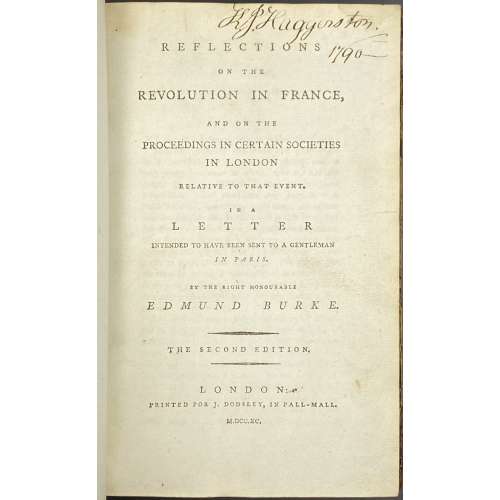 Title: REFLECTIONS | ON THE | REVOLUTION IN FRANCE, | AND ON THE | PROCEEDINGS IN CERTAIN SOCIETIES | IN LONDON | RELATIVE TO THAT EVENT. | IN A | LETTER | INTENDED TO HAVE BEEN SENT TO A GENTLEMAN | IN PARIS. | BY THE RIGHT HONOURABLE | EDMUND BURKE. | — | {in lozenges} THE SECOND EDITION. | —| LONDON: | PRINTED FOR J. DODSLEY, IN PALL-MALL. | M.DCC.XC. || Pagination: [4 blanks] [i-iii] iv, 1-356 [4 blanks]. Collation: 8vo; π2 B-Z8, Aa2. Binding: Quarter calf with marbled boards, gilt fillets, red label with gilt lettering to spine. "King John Haggerston, 1790" handwritten ink inscription to front endpaper, t.p. and p. iii. Seems like Sir John Haggerston, 9th Baronet.
Title: REFLECTIONS | ON THE | REVOLUTION IN FRANCE, | AND ON THE | PROCEEDINGS IN CERTAIN SOCIETIES | IN LONDON | RELATIVE TO THAT EVENT. | IN A | LETTER | INTENDED TO HAVE BEEN SENT TO A GENTLEMAN | IN PARIS. | BY THE RIGHT HONOURABLE | EDMUND BURKE. | — | {in lozenges} THE SECOND EDITION. | —| LONDON: | PRINTED FOR J. DODSLEY, IN PALL-MALL. | M.DCC.XC. || Pagination: [4 blanks] [i-iii] iv, 1-356 [4 blanks]. Collation: 8vo; π2 B-Z8, Aa2. Binding: Quarter calf with marbled boards, gilt fillets, red label with gilt lettering to spine. "King John Haggerston, 1790" handwritten ink inscription to front endpaper, t.p. and p. iii. Seems like Sir John Haggerston, 9th Baronet. -
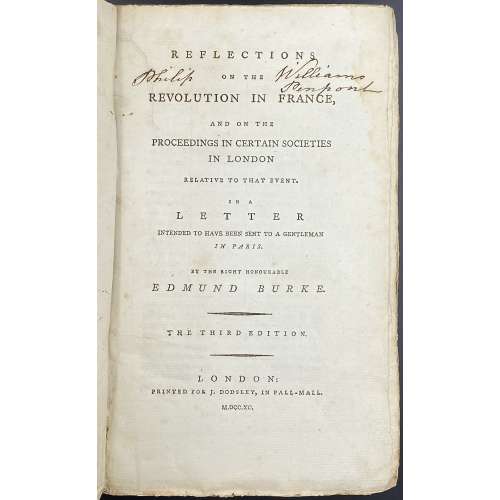 Title: REFLECTIONS | ON THE | REVOLUTION IN FRANCE, | AND ON THE | PROCEEDINGS IN CERTAIN SOCIETIES | IN LONDON | RELATIVE TO THAT EVENT. | IN A | LETTER | INTENDED TO HAVE BEEN SENT TO A GENTLEMAN | IN PARIS. | BY THE RIGHT HONOURABLE | EDMUND BURKE. | — | {in lozenges} THE THIRD EDITION. | —| LONDON: | PRINTED FOR J. DODSLEY, IN PALL-MALL. | M.DCC.XC. || Pagination: [i-iii] iv, [1] 2-364, total 368 pages. Collation: 8vo; π2 B-Z8 Aa6 (plus one blank flyleaf in the front and one in the back), total 184 leaves. Binding: 23 x 14.5 cm, publisher’s paper-backed binding in blue boards with handwritten title to spine (illegible), laid paper, margins untrimmed. Housed in a modern brown cloth clamshell box with brown gilt-lettered label. Note: The second edition same year has a total of 360 pages (iv, 356); see LIB-2590.2021. Inscription to title page: Philip [ON THE] Williams Penpont – that is probably of Philip Williams Esq., of Penpont, Breconshire, Wales. (c. 1742 – 1794).
Title: REFLECTIONS | ON THE | REVOLUTION IN FRANCE, | AND ON THE | PROCEEDINGS IN CERTAIN SOCIETIES | IN LONDON | RELATIVE TO THAT EVENT. | IN A | LETTER | INTENDED TO HAVE BEEN SENT TO A GENTLEMAN | IN PARIS. | BY THE RIGHT HONOURABLE | EDMUND BURKE. | — | {in lozenges} THE THIRD EDITION. | —| LONDON: | PRINTED FOR J. DODSLEY, IN PALL-MALL. | M.DCC.XC. || Pagination: [i-iii] iv, [1] 2-364, total 368 pages. Collation: 8vo; π2 B-Z8 Aa6 (plus one blank flyleaf in the front and one in the back), total 184 leaves. Binding: 23 x 14.5 cm, publisher’s paper-backed binding in blue boards with handwritten title to spine (illegible), laid paper, margins untrimmed. Housed in a modern brown cloth clamshell box with brown gilt-lettered label. Note: The second edition same year has a total of 360 pages (iv, 356); see LIB-2590.2021. Inscription to title page: Philip [ON THE] Williams Penpont – that is probably of Philip Williams Esq., of Penpont, Breconshire, Wales. (c. 1742 – 1794). -
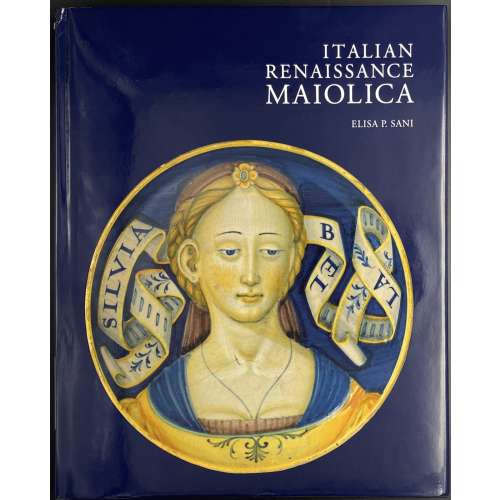 Title page: ITALIAN | RENAISSANCE | MAIOLICA | ELISA P. SANI | with a preface by J.V.G. Mallet and | contributions from Reino Liefkes | V&A PUBLISHING || Pagination: [1-6] 7-192, ils. Binding: Black cloth, gilt lettering to spine; pictorial DJ. Mint/New. Size: 27.7 x 22.2 cm.
Title page: ITALIAN | RENAISSANCE | MAIOLICA | ELISA P. SANI | with a preface by J.V.G. Mallet and | contributions from Reino Liefkes | V&A PUBLISHING || Pagination: [1-6] 7-192, ils. Binding: Black cloth, gilt lettering to spine; pictorial DJ. Mint/New. Size: 27.7 x 22.2 cm. -
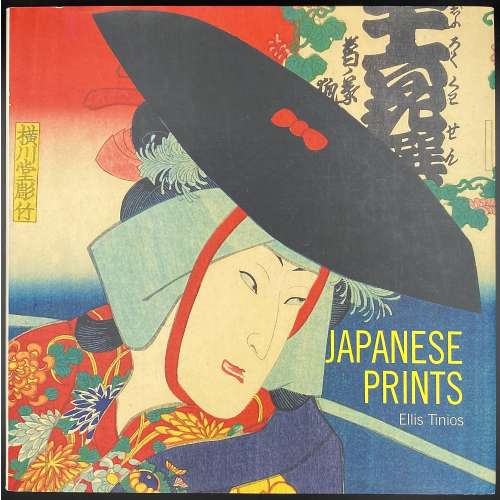 Hardcover, 23.5 x 23.5 cm, publisher's navy cloth, gilt-stamped lettering to spine, pictorial DJ; pp.: [1-6] 7-143 [144 blank].
Hardcover, 23.5 x 23.5 cm, publisher's navy cloth, gilt-stamped lettering to spine, pictorial DJ; pp.: [1-6] 7-143 [144 blank].Japanese woodblock prints of the Edo period (1615-1868) were the products of a highly commercialised and competitive publishing industry. Their content was inspired by the vibrant popular culture that flourished in Edo (Tokyo). At any given time scores of publishers competed for the services of the leading artists of the day. Publishers and artists displayed tremendous ingenuity in finding ways to sustain demand for prints and to circumvent the restrictions placed on the industry through government censorship. Although Japanese prints have long been appreciated in the West for their graphic qualities, their content has not always been fully understood. This book draws on recent scholarship that makes possible a more subtle appreciation of the imagery encountered in the prints and how they would have been read when first made. Through stunning new photography of both well-known and rarely published works in the collection of the British Museum, including many recent acquisitions, the author explores how and why such prints were made, providing a fascinating introduction to a much-loved but little-understood art form.
-
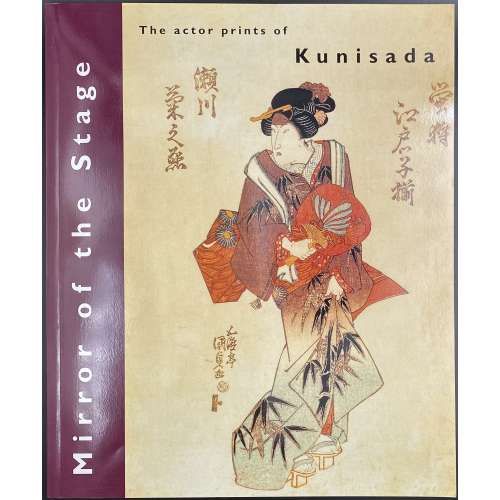 Thin booklet in glossy pictorial wrappers, 29.8 x 24.7 cm, pp.: [1-4] 5-48, 24 leaves total, illustrated. Errata tipped in after the front wrapper. Title-page: Mirror | of the stage | The actor prints of | Kunisada | Ellis Tinios | The University Gallery Leeds || Colophon: Published in March 1996 for the exhibition Mirror of the Stage held at the University Gallery Leeds 24 April-30 May 1996. Introduction: "This book [exhibition catalogue] has been written as an introduction to nineteenth-century Japanese colour woodblock actor prints and to the achievements of the artist Kunisada in that field [as well as to accompany the exhibition of the same name]. It is divided into three sections. In the first, I examine four topics: the social and cultural milieu that gave rise to the production of prints as items of mass consumption; the aesthetic of the actor print; the economics of print production (including consideration of the numbers issued, the prices at which they were sold and their rates of survival); and the process by which prints were produced. The second section consists of sixteen colour plates with commentaries. In the final section, I survey Kunisada's career." Subject: Utagawa, Kunisada, — 1786-1864 — Exhibitions; Ukiyo-e — Exhibitions; Colour prints, Japanese — Edo period, 1600-1868 — Exhibitions. Contributors: Ellis Tinios Utagawa Kunisada [歌川 国貞] a.k.a. Utagawa Toyokuni III [三代歌川豊国] (Japanese, 1786 – 1865). Select illustrations (references in this collection):
Thin booklet in glossy pictorial wrappers, 29.8 x 24.7 cm, pp.: [1-4] 5-48, 24 leaves total, illustrated. Errata tipped in after the front wrapper. Title-page: Mirror | of the stage | The actor prints of | Kunisada | Ellis Tinios | The University Gallery Leeds || Colophon: Published in March 1996 for the exhibition Mirror of the Stage held at the University Gallery Leeds 24 April-30 May 1996. Introduction: "This book [exhibition catalogue] has been written as an introduction to nineteenth-century Japanese colour woodblock actor prints and to the achievements of the artist Kunisada in that field [as well as to accompany the exhibition of the same name]. It is divided into three sections. In the first, I examine four topics: the social and cultural milieu that gave rise to the production of prints as items of mass consumption; the aesthetic of the actor print; the economics of print production (including consideration of the numbers issued, the prices at which they were sold and their rates of survival); and the process by which prints were produced. The second section consists of sixteen colour plates with commentaries. In the final section, I survey Kunisada's career." Subject: Utagawa, Kunisada, — 1786-1864 — Exhibitions; Ukiyo-e — Exhibitions; Colour prints, Japanese — Edo period, 1600-1868 — Exhibitions. Contributors: Ellis Tinios Utagawa Kunisada [歌川 国貞] a.k.a. Utagawa Toyokuni III [三代歌川豊国] (Japanese, 1786 – 1865). Select illustrations (references in this collection):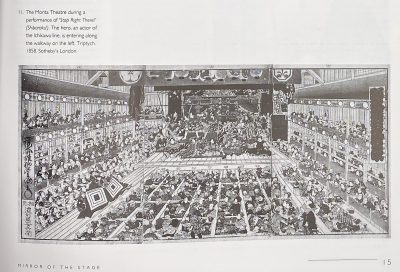
SVJP-0226.2016: Superb Edo pictures illustrating dances, 1858.
-
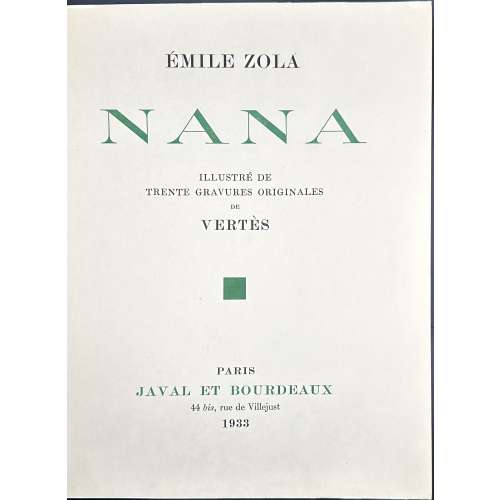 Publisher’s olive French flapped wrappers, in-4to, 33 x 25.3 x 6 cm, green and black lettering to front and spine, in a glassine dust jacket, in a marbled double slipcase 34.5 x 25.5 cm, unbound; pp.: [8] 1-436 [4], plus 30 colour plates with guard tissue, extraneous to collation; edition enriched with a set of 30 uncoloured etchings with guard tissue in a lettered paper folder. Title-page: ÉMILE ZOLA | NANA | ILLUSTRÉ DE | TRENTE GRAVURES ORIGINALES | DE | VERTÈS |◾| PARIS | JAVAL ET BOURDEAUX | 44 bis, rue de Villejust | 1933 || Justification du tirage: il a été tiré de «Nana » d'Émile Zola. Soixante exemplaires sur japon impérial, numérotés de 1 a 60, avec un état en couleurs colorié a la main et un état en noir des trente gravures originales de Vertès. [Edition limited to 60 copies, this is copy № 54]. Colophon: « NANA », D'ÉMILE ZOLA, ÉTÉ ACHEVÉ D'IMPRIMER LE TRENTE AVRIL MIL NEUF CENT TRENTE-TROIS, EN CARACTÈRES ROMAIN ANGLAIS DU CORPS 16, SUR LES PRESSES DU MAITRE IMPRIMEUR COULOUMA, À ARGENTEUIL, H. BARTHÉLEMY, DIRECTEUR. LES COMPOSITIONS DE VERTÈS ONT ÉTÉ REPRODUITES EN FAC-SIMILÉ PAR D. JACOMET & Cie. Printed on April 30, 1933 by Coulouma in Argenteuil, H. Barthélemy, director; illustrations reproduced in facsimile by D. Jacomet & Co. Catalogue raisonné: Vokaer 30. Contributors: Émile Zola (French, 1840 – 1902) – author. Marcel Vertès [Marcell Vértes] (Jewish-Hungarian-French, 1895 – 1961) – artist. Javal et Bourdeaux – publisher. Daniel Jacomet (French, 1894 – 1966) – printer. Seller's description: Nana. Paris, Javal et Bourdeaux, 1933. 2 volumes in-4, en feuilles, non coupé, non rogné, chemise et étui. Ouvrage illustré de 30 gravures originales en couleurs de Marcel Vertès. Tirage à 60 exemplaires sur japon impérial contenant un état des illustrations coloriées à la main en couleurs et un état en noir. Chemise et emboîtage insolés.
Publisher’s olive French flapped wrappers, in-4to, 33 x 25.3 x 6 cm, green and black lettering to front and spine, in a glassine dust jacket, in a marbled double slipcase 34.5 x 25.5 cm, unbound; pp.: [8] 1-436 [4], plus 30 colour plates with guard tissue, extraneous to collation; edition enriched with a set of 30 uncoloured etchings with guard tissue in a lettered paper folder. Title-page: ÉMILE ZOLA | NANA | ILLUSTRÉ DE | TRENTE GRAVURES ORIGINALES | DE | VERTÈS |◾| PARIS | JAVAL ET BOURDEAUX | 44 bis, rue de Villejust | 1933 || Justification du tirage: il a été tiré de «Nana » d'Émile Zola. Soixante exemplaires sur japon impérial, numérotés de 1 a 60, avec un état en couleurs colorié a la main et un état en noir des trente gravures originales de Vertès. [Edition limited to 60 copies, this is copy № 54]. Colophon: « NANA », D'ÉMILE ZOLA, ÉTÉ ACHEVÉ D'IMPRIMER LE TRENTE AVRIL MIL NEUF CENT TRENTE-TROIS, EN CARACTÈRES ROMAIN ANGLAIS DU CORPS 16, SUR LES PRESSES DU MAITRE IMPRIMEUR COULOUMA, À ARGENTEUIL, H. BARTHÉLEMY, DIRECTEUR. LES COMPOSITIONS DE VERTÈS ONT ÉTÉ REPRODUITES EN FAC-SIMILÉ PAR D. JACOMET & Cie. Printed on April 30, 1933 by Coulouma in Argenteuil, H. Barthélemy, director; illustrations reproduced in facsimile by D. Jacomet & Co. Catalogue raisonné: Vokaer 30. Contributors: Émile Zola (French, 1840 – 1902) – author. Marcel Vertès [Marcell Vértes] (Jewish-Hungarian-French, 1895 – 1961) – artist. Javal et Bourdeaux – publisher. Daniel Jacomet (French, 1894 – 1966) – printer. Seller's description: Nana. Paris, Javal et Bourdeaux, 1933. 2 volumes in-4, en feuilles, non coupé, non rogné, chemise et étui. Ouvrage illustré de 30 gravures originales en couleurs de Marcel Vertès. Tirage à 60 exemplaires sur japon impérial contenant un état des illustrations coloriées à la main en couleurs et un état en noir. Chemise et emboîtage insolés.


